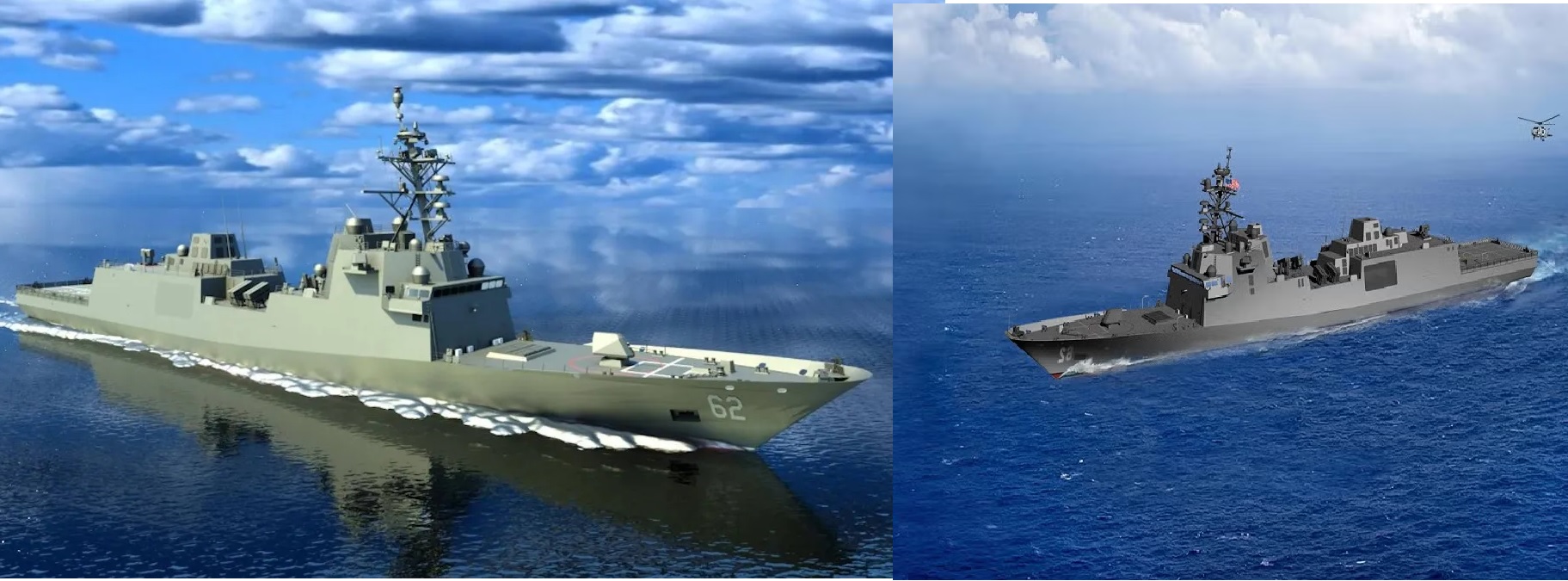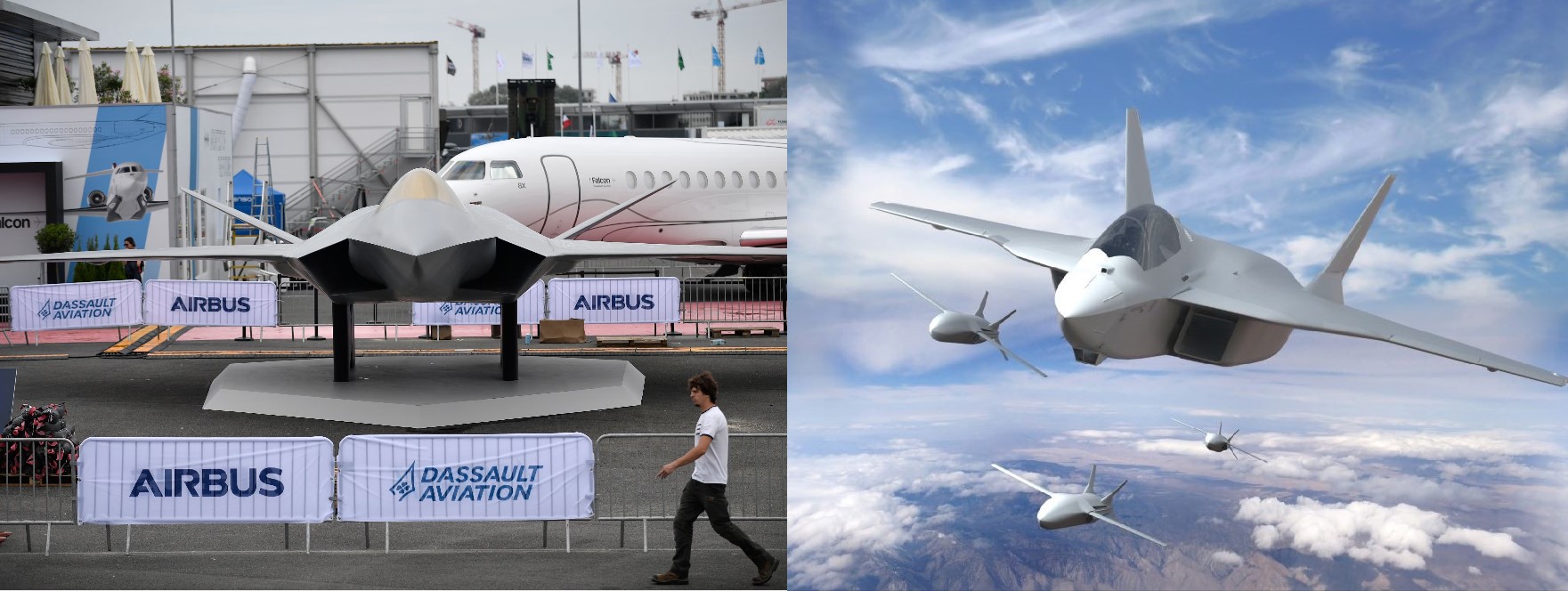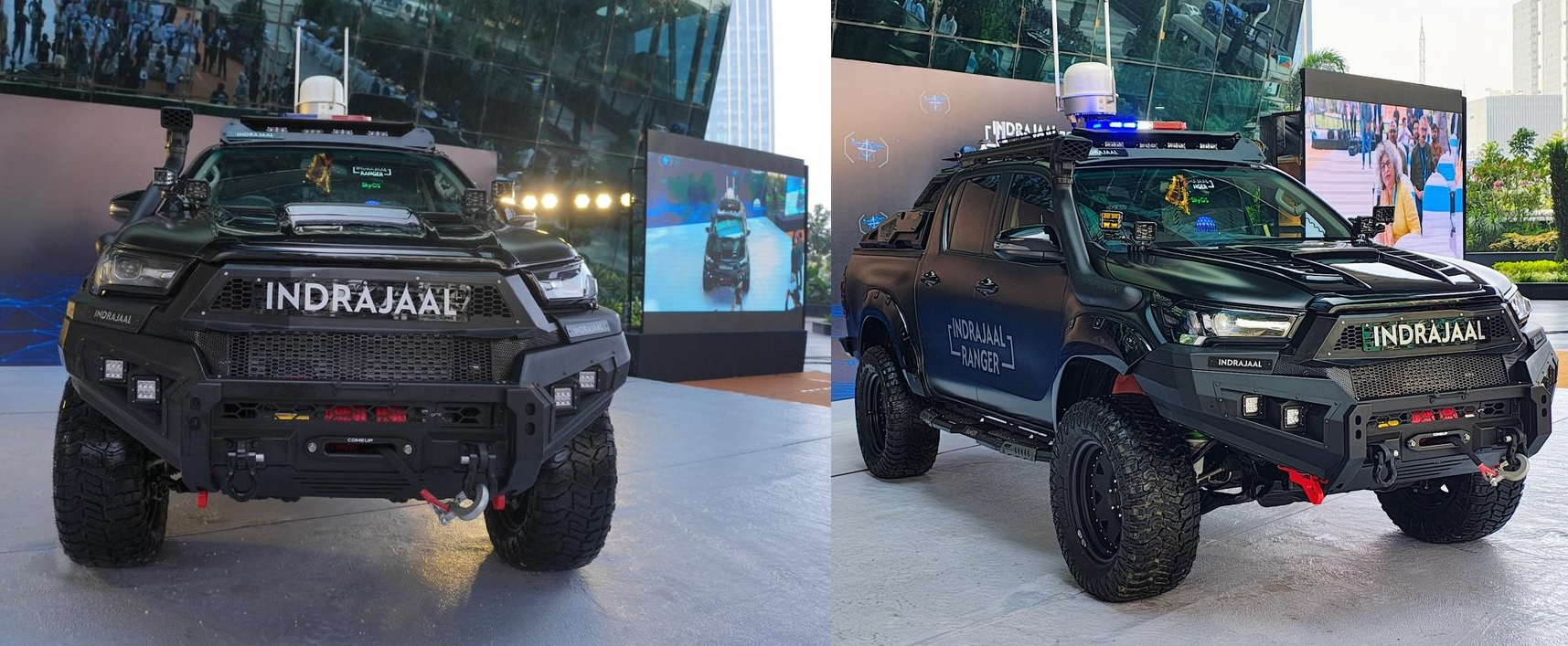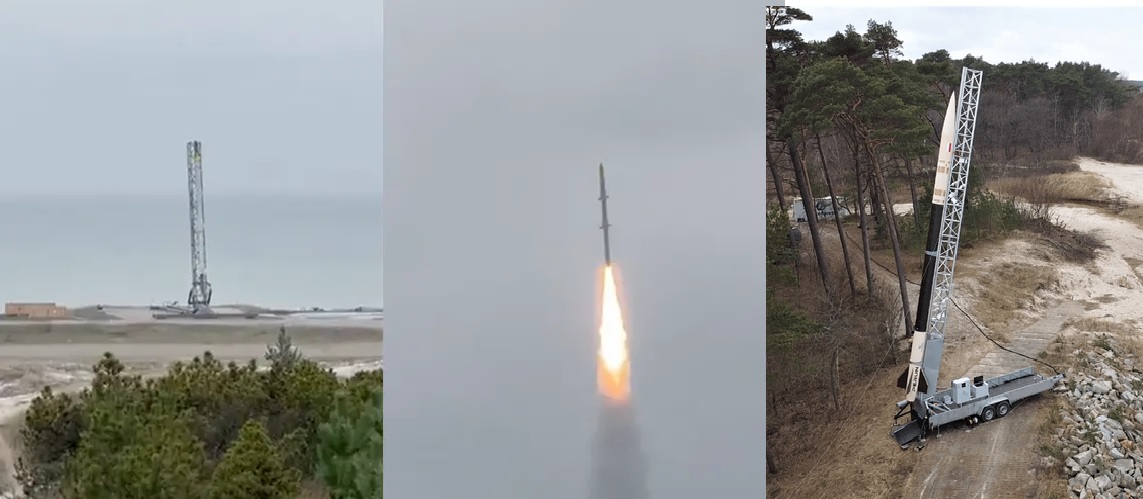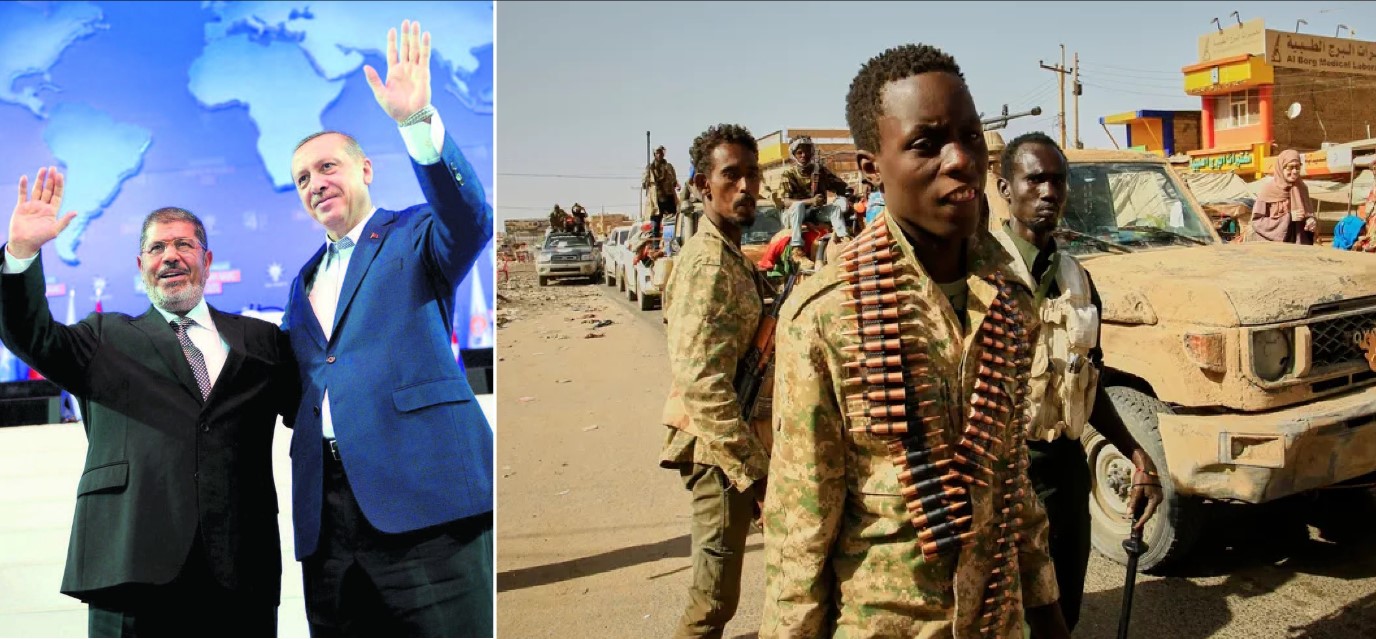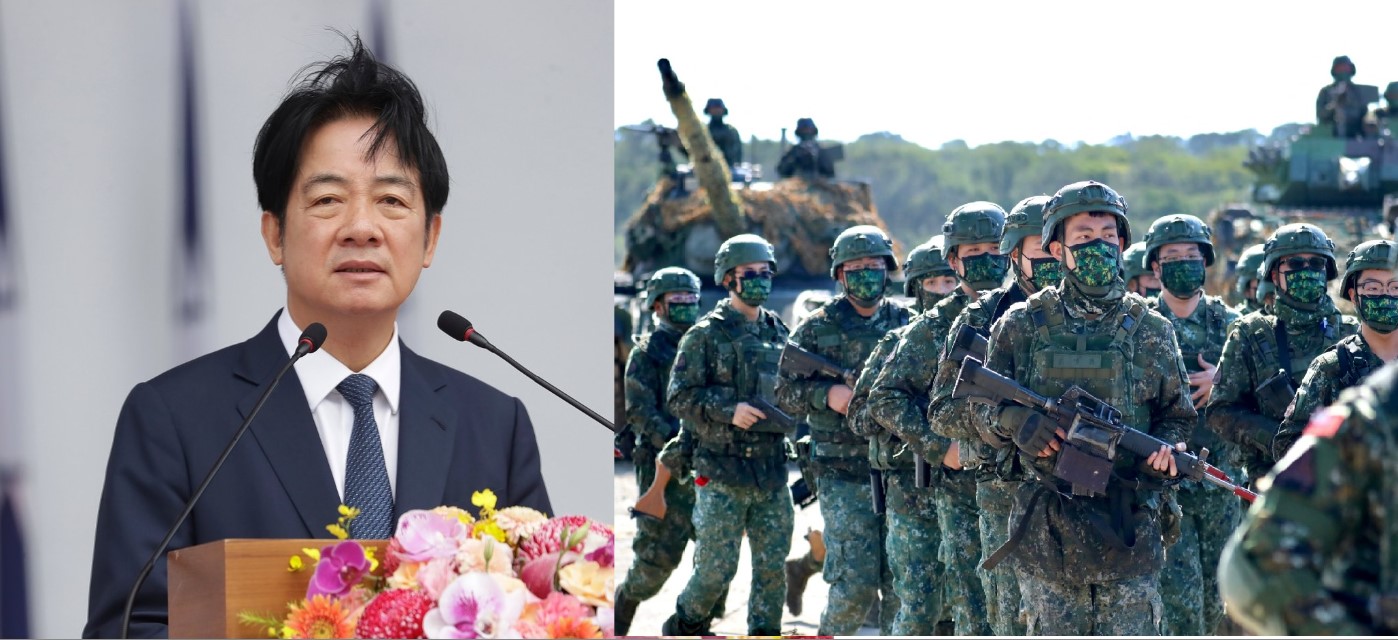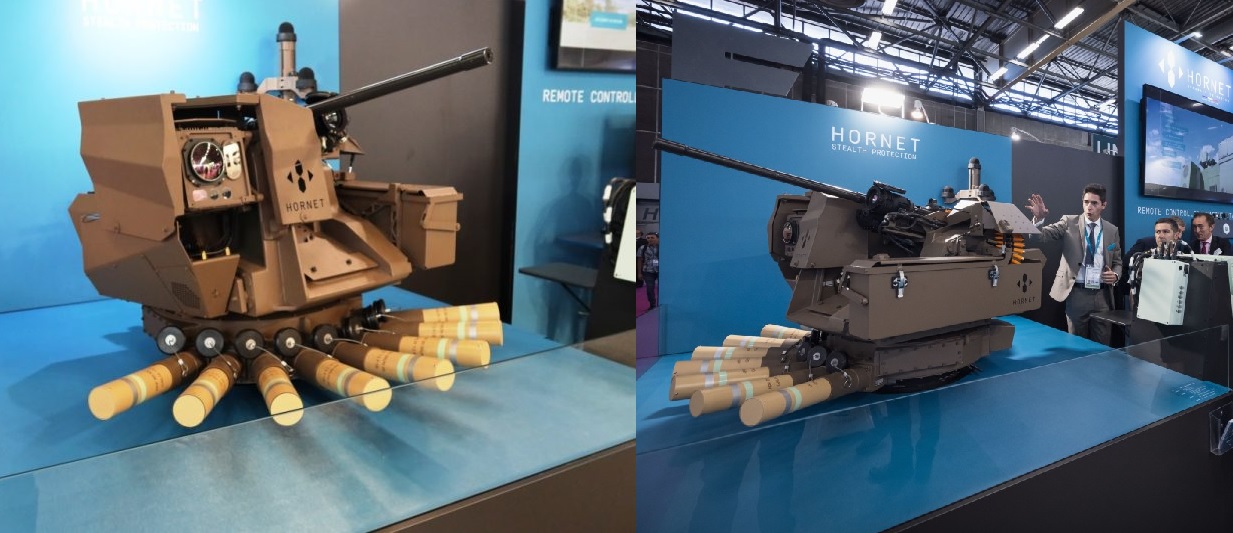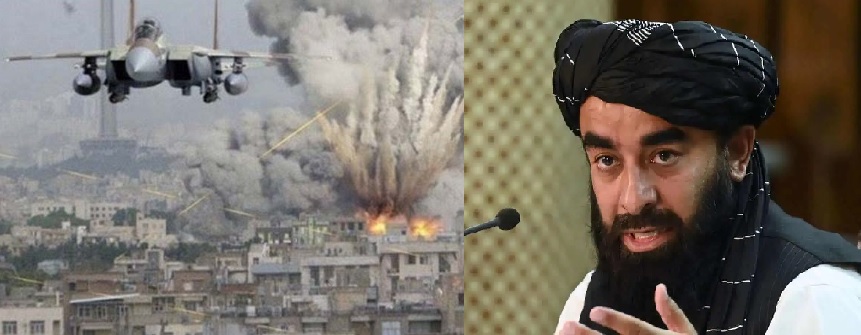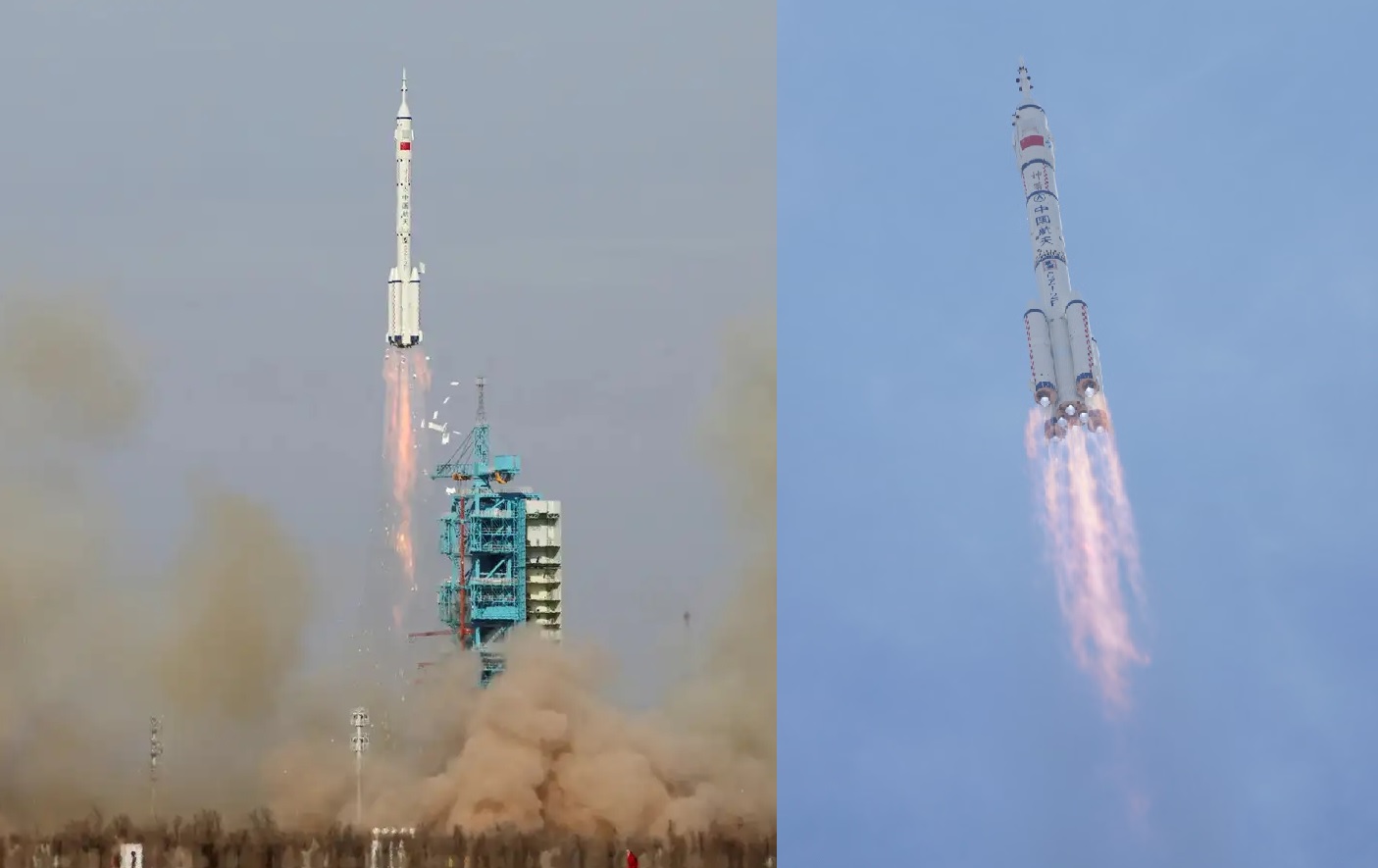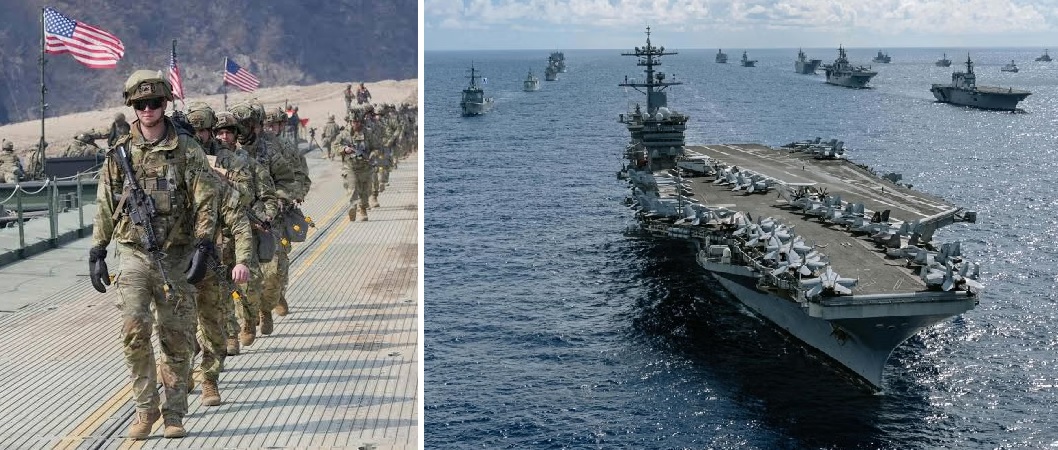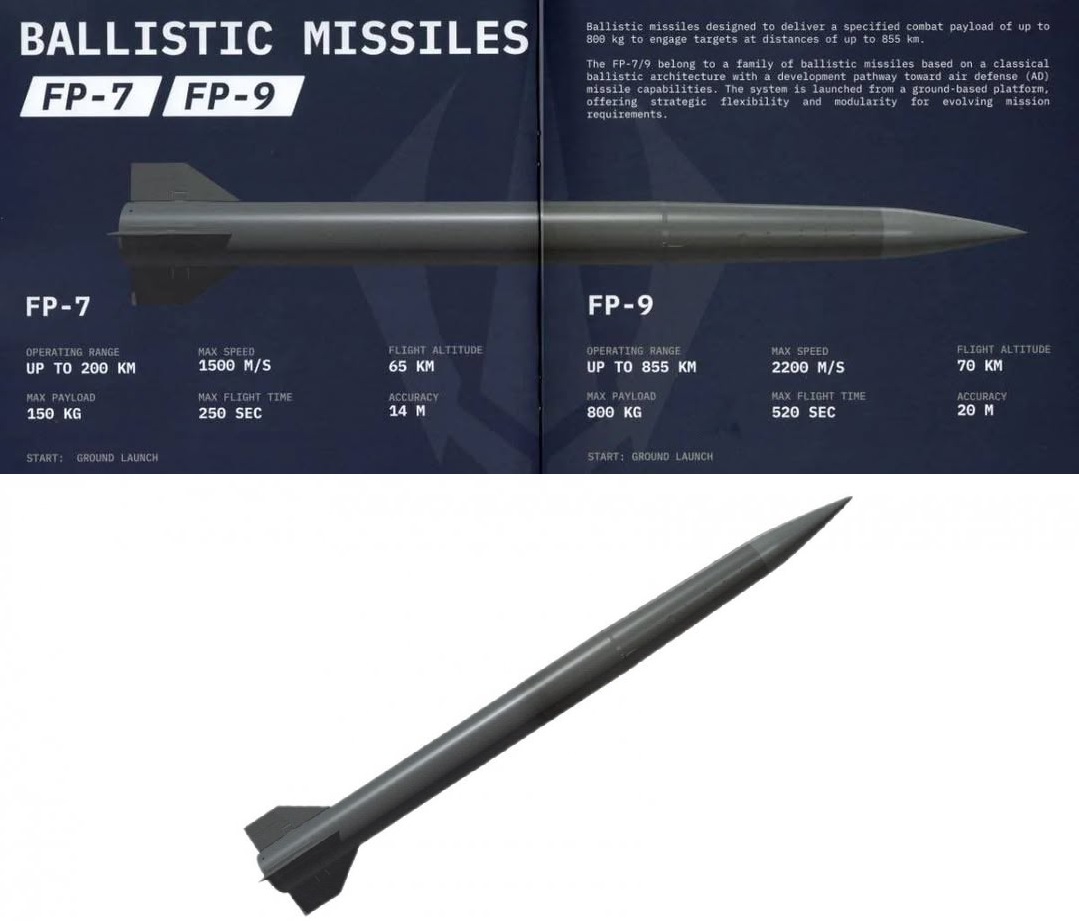World
A $30 million U.S. MQ-9 Reaper reconnaissance drone crashed into the Yellow Sea early Monday morning, roughly 15 miles off South Korea’s western coast, triggering a three-way strategic scramble between Washington, Seoul, and Beijing as each seeks to control access to the wreckage. The drone went down near Maldo-ri Island, off the coast of Okdo-myeon in Gunsan, according to early reports first carried by Korea JoongAng Daily. The aircraft was being operated by the 431st Expeditionary Reconnaissance Squadron out of Kunsan Air Base, a major American hub roughly 180 kilometers south of Seoul. A spokesperson for U.S. Forces Korea (USFK) confirmed the crash, stating that the MQ-9 was on a routine surveillance mission when it “experienced an in-flight incident” before plunging into the sea. No injuries or damage to civilian property were reported, and an investigation has begun to determine the cause. A Strategically Sensitive Crash Site While crashes of U.S. military aircraft in the region are not unprecedented, the location of this incident is the true source of geopolitical friction. The Yellow Sea—particularly the band of waters between China and South Korea—has become a hotspot of maritime confrontation throughout 2025. Both Beijing and Seoul have repeatedly accused each other of airspace violations, aggressive naval maneuvers, and radar lock-on incidents in this zone. The U.S. MQ-9 went down precisely in an area where Chinese maritime patrol vessels frequently operate and where South Korea has been expanding its own surveillance grid. This proximity raises the risk of a race to recover the wreckage, as the Reaper carries sensitive sensors, communications gear, and mission data valuable to foreign intelligence services. U.S. Navy recovery teams from bases in Japan and Guam were reportedly mobilized within hours. South Korean naval units were also dispatched, but Beijing’s response has yet to be confirmed. Foreign military observers say China may view the crash site as falling within waters it regularly patrols, heightening the possibility of an encounter during recovery operations. Rapid U.S. Response and Regional Concerns Washington is acutely aware of the implications of losing a high-end drone like the MQ-9 in contested waters. Reapers deployed to Korea are believed to carry upgraded ISR suites optimized for North Korean missile monitoring, Chinese naval movements, and electronic intelligence. Analysts warn that any delay in recovery increases the risk of sensitive technologies falling into the hands of adversaries. This crash also comes at a time when the Pentagon is expanding unmanned reconnaissance patrols across the Indo-Pacific. The U.S. permanently stationed MQ-9 Reapers on the Korean Peninsula in September 2025, enhancing long-range surveillance of North Korea’s accelerating missile tests and tracking Chinese submarines entering the Yellow Sea. A String of U.S. and South Korean Aircraft Incidents The incident adds to a growing list of aviation mishaps in the region: In June 2025, South Korea temporarily grounded its KF-16 fighters after one was damaged during joint drills in Alaska. In October 2025, a U.S. Navy F/A-18 Super Hornet and a MH-60 helicopter crashed separately in the South China Sea. North Korea’s ongoing missile launches have kept regional air forces on high alert, further stressing flight operations. With more than 28,500 U.S. troops stationed on the peninsula, Washington and Seoul continue to maintain high-tempo aerial and maritime surveillance as Pyongyang tests new weapons and Beijing increases its maritime presence. Investigation Underway, But Strategic Stakes Loom Larger USFK has stated that the cause of the MQ-9’s loss remains unknown, though early assessments rule out hostile action. Mechanical failure, weather conditions, or system malfunction remain possible factors. Still, the broader concern is not how the Reaper crashed, but where. The Yellow Sea has emerged as one of Asia’s most contested maritime zones, and the presence of a downed American surveillance drone adds another layer of tension to an already volatile triangle between the U.S., China, and South Korea. For now, the priority for U.S. forces is clear: recover the wreckage before currents—or competitors—reach it first. The coming days may determine whether this incident remains a technical mishap or escalates into a diplomatic flashpoint in one of the region’s most sensitive waters.
Read More → Posted on 2025-11-26 16:49:23World
In a major restructuring of its surface fleet plans, the U.S. Navy has terminated the final four ships in the Constellation-class guided-missile frigate program, effectively reducing the long-planned acquisition effort to just the two vessels currently under construction. The decision marks a dramatic reversal for a program once envisioned as the backbone of the Navy’s future small-surface-combatant fleet. The Navy confirmed that only USS Constellation (FFG-62) and USS Congress (FFG-63) will move forward at Fincantieri Marinette Marine shipyard in Wisconsin, ending U.S. ambitions for a 20-ship Constellation fleet set to cost more than $22 billion. A Program That Struggled From the Start Launched in 2020, the Constellation-class program was intended to replace aging Littoral Combat Ships (LCS) — both Freedom and Independence variants — and to succeed the well-worn Oliver Hazard Perry-class frigates retired nearly two decades ago. The new ships were expected to deliver improved survivability, anti-ship capabilities, advanced sensors, and a credible multi-mission platform suited for contested maritime environments. But from its earliest stages, the program encountered persistent turbulence. Repeated design changes, driven partly by evolving threat assessments and integration challenges with U.S. weapons and combat systems, added months of redesign work. Major suppliers reported difficulties aligning their systems with the modified parent design (an enlarged derivative of the Italian FREMM frigate), forcing further delays. A 2024 U.S. Government Accountability Office (GAO) report warned of significant schedule slippages and rising costs. The first ship, originally intended for delivery in 2026, is now forecast to be completed in 2029 — a three-year delay. Meanwhile, unit costs grew to an estimated $1.4 billion per ship, far above the initial expectation of roughly $940 million. Why the U.S. Navy Cancelled the Remaining Ships According to senior defense officials, several combined factors drove the cancellation: Schedule instability: The repeated redesign work created a production timeline the Navy viewed as “unrecoverable” within required readiness targets. Escalating costs: The program’s per-unit cost trajectory threatened to divert funding from other critical shipbuilding priorities. Capability overlap: Advances in other platforms — including destroyers, unmanned surface vessels, and expanded upgrades to existing ships — reduced the strategic urgency for a new frigate fleet. Strategic recalibration: The Navy is shifting toward distributed maritime operations with a greater mix of manned-unmanned platforms rather than traditional mid-sized combatants. U.S. Navy Secretary John Phelan framed the decision as part of a broader modernization push. “From day one, I made it clear: I won’t spend a dollar if it doesn’t strengthen readiness or our ability to win,” Phelan said. “We are reshaping how the Navy builds its fleet … a strategic shift away from the Constellation-class frigate program.” Privately, officials remarked that the Navy believes it can field more flexible capabilities through unmanned vessels, upgraded destroyers, and investments in missile-defense modernization rather than waiting for a delayed and over-budget frigate. Fincantieri Responds: Work Will Continue on First Two Ships Italian shipbuilding giant Fincantieri, which operates major U.S. shipyards under its Fincantieri Marinette Marine subsidiary, issued a measured response to the news. The company confirmed it will continue production of FFG-62 and FFG-63, while pursuing new naval contracts. CEO George Moutafis stated that the Navy’s decision “provides for the necessary stability for our teams … allowing us to continue investing in innovation and skills.” Fincantieri’s presence in the United States remains substantial. Its shipyards in Marinette, Green Bay, and Sturgeon Bay — along with its Jacksonville facility — employ approximately 3,750 workers. The company recently hired an additional 850 employees, supported by over $800 million in yard modernization investments to improve production capacity and adapt to future programs, including amphibious vessels, icebreakers, and special mission ships. What Comes Next for the U.S. Navy With the cancellation of the remaining Constellation-class orders, the Navy will redirect funding toward: Fleet modernization initiatives Unmanned surface and underwater vehicles Industrial base strengthening Upgrades to Arleigh Burke-class destroyers Accelerated development of next-generation surface combatants Analysts suggest this move underscores the Navy’s shift toward a more distributed, high-tech fleet structure, reflecting the challenges of competing with China’s rapidly expanding naval power. While the Constellation-class will not become the large frigate fleet once envisioned, the two ships under construction will still serve as valuable testbeds for future surface warfare technologies and doctrinal concepts. The cancellation marks a significant moment in U.S. naval procurement — a recognition that legacy shipbuilding models may struggle to keep pace with the demands of modern maritime competition, and that the Navy must adapt quickly to secure technological and operational advantage in the decades ahead.
Read More → Posted on 2025-11-26 16:26:24World
France and Germany have intensified pressure on Dassault Aviation and Airbus Defence and Space to resolve a long-running industrial dispute that now threatens the future of the €100 billion Future Combat Air System (FCAS), Europe’s most ambitious next-generation fighter program. With a critical mid-December deadline approaching, both governments are urging the two aerospace giants to sign a long-delayed cooperation agreement that has been stalled for years over disagreements on workshare, leadership, and access to sensitive technologies. The FCAS project — jointly developed by France, Germany, and Spain — is intended to deliver a sixth-generation stealth fighter, loyal wingman drones, and a highly networked combat cloud capable of linking future European military platforms. But the core of the program has been repeatedly paralysed by deep divisions between Dassault and Airbus, raising concerns that Europe’s most important defence initiative could unravel. What Is the Problem Between Dassault and Airbus? At the heart of the dispute are three major points of contention: 1. Who leads the fighter jet design?Dassault insists on retaining full authority over the Next Generation Fighter (NGF) — the centrepiece of FCAS. The French firm argues that as the designer of the Rafale and Mirage, it alone has the expertise and must act as the prime contractor. Airbus, however, demands a more equal leadership role, arguing that Germany’s industry cannot accept a subordinate position on a €100 billion program. 2. Access to critical “sovereign technologies.”Dassault refuses to share certain sensitive, proprietary technologies — including flight-control systems, stealth design processes, and key avionics — citing national security and export regulations. Airbus argues that without shared access, the program cannot be truly joint and Germany will be unable to maintain or upgrade the aircraft independently in the future. 3. Workshare and industrial responsibilities.France wants Dassault to handle core aircraft architecture, while Airbus performs more peripheral tasks. Germany insists on an even split. The dispute over dividing work for the NGF, remote carriers (drones), engines, and cloud systems has repeatedly halted progress. These disagreements have caused the program to miss multiple milestones, push back contracts, and strain political confidence on both sides. Governments Increase Pressure French Defence Minister Sébastien Lecornu and German Defence Minister Boris Pistorius have jointly warned that time is running out. Both governments expect the companies to finalise a cooperation agreement before mid-December, stressing that further delays put the entire FCAS roadmap at risk. Officials say the tensions have reached a point where political intervention has become unavoidable. The fear is that continued industrial deadlock could derail the “Phase 1B” development stage and cause long-term schedule slippages. Fallback Options if Talks Collapse Europe is now quietly preparing for the possibility that Dassault and Airbus fail to reach an accord. According to defence insiders, two fallback scenarios are being considered: Each country develops its own next-generation jet, mirroring past divergences such as the Rafale-Eurofighter split. FCAS is reduced to a shared “combat cloud”, with France and Germany producing separate fighter aircraft but integrating their digital networks. Either option would significantly dilute the original FCAS vision of an integrated, pan-European air-combat ecosystem. A Blow to Europe’s Strategic Autonomy A collapse of FCAS would have far-reaching consequences. The program was conceived to strengthen Europe’s defence independence, reduce reliance on U.S. platforms, and unify European aerospace industries. Two separate jets would mean duplicated budgets, competing designs, and reduced interoperability — undermining the very goals FCAS was meant to achieve. Analysts also note that delays have already caused program slippage. Even if an agreement is reached soon, lost time could push the first FCAS fighter well beyond its planned 2040 entry-into-service window. For now, both Paris and Berlin are watching negotiations closely. The upcoming mid-December deadline is viewed as a decisive moment — one that will determine whether FCAS moves forward as Europe’s flagship future fighter, or fractures under the weight of industrial rivalry and competing national interests.
Read More → Posted on 2025-11-26 15:45:07World
The U.S. Navy has taken a significant step toward reshaping its future undersea warfare arsenal by moving ahead with RAPTOR (Rapid Acquisition Procurable Torpedo), a new heavyweight torpedo program designed to be far cheaper, faster to produce, and scalable compared to the Navy’s existing Mk-48 ADCAP inventory. A brief contract notice published on November 21 by the Pentagon’s Strategic Capabilities Office (SCO) confirms the Navy’s intent to seek industry proposals for the torpedo under contract number SCO-PS-26-01, marking the first formal move since the program was publicly revealed in 2024 by The War Zone. A Torpedo Designed for Future High-Intensity Conflict RAPTOR is envisioned as a new class of affordable 21-inch (533 mm) heavyweight torpedo compatible with all U.S. Navy nuclear attack submarines. The system is specifically aimed at bolstering magazine depth and production capacity as the Navy prepares for potential high-end conflicts where mass, speed of production, and cost-efficiency may be as critical as raw performance. According to earlier reports, RAPTOR is projected to cost around $500,000 per unit—dramatically lower than the current Mk-48 ADCAP MOD 7, which costs over $4 million per torpedo, as revealed in Fiscal Year 2025 budget documents. The Navy bought 79 Mk-48 MOD 7 units at that price point, underscoring growing concerns about sustaining stockpiles for prolonged conflict. A Lower-Cost Weapon, Same Lethal Punch While RAPTOR is intended to be less sophisticated than the Mk-48 family, it is not expected to compromise on destructive power. “This is a mission-specific, limited-capability weapon, but it’s still the same explosive yield,”said Captain Chris Polk, Undersea Weapons Program Manager, in comments reported by The War Zone. The main cost savings are expected from reductions in sensors, guidance systems, or mission-adaptable targeting capabilities. Experts suggest RAPTOR may: Feature simpler guidance algorithms Have reduced run time or range Omit complex submarine-hunting modes Be optimized for specific mission sets like surface strike, mine-clearing, or close-range engagements This makes the weapon ideal for high-volume production during emergencies while preserving the Mk-48 torpedoes for priority targets like advanced submarines or capital ships. The Mk-48: Still the Backbone of U.S. Submarine Firepower The heavyweight Mk-48 torpedo remains the U.S. Navy’s primary undersea weapon for over 40 years, evolving through multiple upgrades: Mk-48 ADCAP MOD 7, with improved software and control systems, entered service in 2006. Mk-48 MOD 8 (APB 6 / Tech Insertion-1) introduces an all-new guidance section, denser sonar array, modern transmitter/receiver suite, a revamped warhead electronics package, and enhanced fiber-optic guidance for better post-launch communications. Mk-48 MOD 9 (APB 7 / Tech Insertion-2) is in development, promising upgraded propulsion, range, and sensing capabilities. Notably, budget documents assign MOD 8 and MOD 9 to different mission roles, offering “two distinctly different capabilities.” These improvements reflect the Navy’s need to counter increasingly quiet Chinese and Russian submarines. Beyond Heavyweights: The Rise of Compact Attack Torpedoes In parallel to RAPTOR, the Navy is pursuing Project Revolver, an initiative to greatly expand torpedo magazine capacity on attack submarines. The program explores packing multiple MK 58 Compact Rapid Attack Weapons (CRAW)—a lightweight 6.75-inch torpedo—into standard torpedo rooms, countermeasure tubes, or even vertical launch cells on Virginia-class SSNs. If successful, Project Revolver would allow a submarine to deploy dozens of lightweight torpedoes for close-range engagements, drone defense, or swarming anti-ship scenarios, while reserving heavyweights for critical kills. Why RAPTOR Matters Now The push for a rapid-production torpedo comes amid a shifting global security landscape: The U.S. Navy is preparing for potential conflict in the Western Pacific where mass-produced munitions could decide the outcome. China’s rapid naval modernization has prompted urgency in boosting U.S. magazine depth. The U.S. industrial base has struggled to ramp up heavyweight torpedo production, with long lead times and limited suppliers. High-end munitions like the Mk-48 are too expensive to procure in the quantities needed for a prolonged fight. RAPTOR, therefore, is not meant to replace the Mk-48 but to complement it, providing a low-cost, rapidly manufacturable weapon for scenarios where cheaper torpedoes can be used without sacrificing destructive power. A New Torpedo Era Begins With the contract notice officially released and industry engagement now underway, the RAPTOR program appears to be accelerating. If successfully funded and adopted, RAPTOR could represent the most significant transformation in U.S. torpedo strategy since the introduction of the Mk-48, enabling America’s submarine fleet to field more weapons, at lower cost, in less time. The Navy has not disclosed timelines for prototype development or testing, but analysts expect early production models could emerge before the decade’s end, marking the beginning of a new era in scalable undersea warfare.
Read More → Posted on 2025-11-26 15:33:54India
n a major boost to India’s internal security and border protection architecture, Indrajaal Drone Defence has launched the country’s first Anti-Drone Patrol Vehicle (ADPV) — a fully mobile, AI-enabled counter-drone platform capable of detecting, tracking, and neutralising hostile drones while on the move. The system, showcased as the Indrajaal Ranger, marks a technological leap in India’s response to the rapidly growing menace of drone-based smuggling, reconnaissance, and terrorist operations. A Patrol Vehicle That Fights in Motion Unlike traditional counter-UAS systems that operate from fixed locations, the ADPV is built on a rugged all-terrain 4×4 vehicle and is engineered for high-mobility missions along vulnerable borders, urban corridors, and critical infrastructure zones. According to Indrajaal: Drone detection range: up to 10 km Neutralisation range: up to 4 km Response time: real-time tracking and engagement even while the vehicle is moving Coverage: 360-degree situational awareness through AI-driven autonomous monitoring The ADPV integrates electro-optical sensors, RF-capture arrays, radar modules, and autonomous decision-support algorithms to identify drone types, assess threat levels, and initiate countermeasures almost instantly. Built to Counter Drone-Led Smuggling and Terror Operations The urgency for such a system was reinforced by multiple recent incidents that exposed how drones have become a preferred smuggling tool for cross-border networks: ISI-backed drone routes have been used to drop weapons, drugs, IEDs, and cash deep inside Indian territory. The Border Security Force (BSF) has neutralised over 255 Pakistani drones in 2025 alone, highlighting a massive spike in drone-based trafficking attempts. Urban centers including Delhi, Mumbai, and Chandigarh have reported cartel-driven drone drops, indicating smuggling networks have extended their operations beyond border states. Indrajaal notes that India’s ₹3-lakh-crore drug trafficking ecosystem is increasingly dependent on drones, making counter-drone mobility essential. The Indrajaal Ranger: What’s Inside the Machine While full specifications remain classified, sources indicate the Ranger includes: AI-enabled autonomous threat evaluation platform Multi-layered sensor fusion suite for radar, RF, EO/IR detection Electronic warfare-based soft-kill options Hard-kill interceptors for situations where disabling via jamming is not sufficient Encrypted communication and battlefield networking 360° continuous surveillance dome High-output power systems to support EW operations on the move Indrajaal’s proprietary “Wide Area Drone Defence System (WADDS)” software forms the backbone of the Ranger, enabling scalable response protocols across varied terrains and threat densities. Why This Matters Now India is facing an unprecedented rise in drone-based incidents, with infiltrations along the Pakistan border increasing by more than 400 percent over the past three years. Cartel networks now rely heavily on drones to conduct rapid, low-risk deliveries of heroin and synthetic drugs into Indian territory. At the same time, security agencies have recently intercepted IED-laden drones in Punjab and Kashmir, revealing a deepening link between drone technology and terrorist operations. Critical infrastructure — airports, refineries, and military bases — is also experiencing heightened hostile surveillance, highlighting the growing sophistication of drone-enabled reconnaissance. Traditional fixed counter-drone systems are no longer adequate to tackle these evolving threats, as adversaries continually alter flight paths, timings, and payload tactics. This dynamic environment demands mobile counter-drone solutions that can respond instantly to unpredictable drone routes. The Anti-Drone Patrol Vehicle (ADPV) addresses this challenge by providing a fast-moving, frontline defence shield capable of detecting, tracking, and neutralising hostile drones in real time, even while in motion. India’s Counter-Drone Warfare The deployment of the ADPV marks a decisive shift in India’s approach to drone defence, signalling the country’s move toward integrated, indigenous, and autonomous security solutions rather than reliance on imported systems. With its advanced mobility and AI-enabled capability, the Indrajaal Ranger is expected to strengthen national security across multiple operational environments. Security experts believe the vehicle will become vital for safeguarding border regions such as Punjab, Rajasthan, and Jammu, where cross-border drone activity has surged. It is also poised to enhance the safety of major metropolitan cities by countering criminal drone operations within urban spaces. Beyond this, the ADPV is expected to play a significant role in securing VIP events, critical infrastructure, and sensitive defence corridors, where rapid and precise threat response is essential. It will also support police forces, CAPFs, and military units during high-risk deployments requiring immediate counter-drone action. The Indrajaal Ranger is now expected to undergo evaluation by major central agencies, including the BSF, CRPF, NSG, and several state police forces, marking the beginning of a new era in India’s fight against aerial threats. “Every Drone Intercepted is a Life Protected” At the launch event, officials emphasised that the system is designed to save lives, not just intercept drones. With India facing an unprecedented wave of drone-enabled smuggling, terror infiltration, and espionage, the ADPV offers a crucial real-time defence layer. Indrajaal’s innovation may soon become a standard tool across India’s borders and cities — marking a decisive step toward modern, AI-driven homeland security.
Read More → Posted on 2025-11-26 15:04:13Space & Technology
Poland has taken a major leap in its growing aerospace and defense ambitions, successfully test-launching a domestically built three-stage suborbital rocket at the Ustka test range on the Baltic Sea. Deputy Defense Minister Cezary Tomczyk announced the achievement on Monday, calling it an important milestone in the development of Poland’s indigenous missile and space-launch capabilities. A Rocket That Hit Every Mark According to Polish defense officials, the rocket reached an altitude of 65 kilometers, completing stage separation, guidance, and trajectory performance exactly as planned. While the system was designed primarily for scientific and technological experiments in near-space, Tomczyk hinted that its capability could extend far beyond research use in the future. Defense analysts note that a reliable three-stage booster with precision guidance could form the technological basis for tactical long-range strike systems, should Warsaw decide to move in that direction. Although officials stopped short of confirming military intentions, the test’s location at a military range and the Ministry of Defense’s direct involvement signal clear dual-use potential. Another Polish Rocket Takes to the Sky The successful launch follows a second milestone at the same site just days earlier. On Saturday, SpaceForest, a rapidly emerging Polish private aerospace firm, conducted a successful test flight of its PERUN suborbital rocket. That vehicle reached an altitude of 50 km, validating flight-control systems and propulsion technologies developed entirely within Poland. SpaceForest has been working on PERUN under a broader plan to create low-cost reusable rockets capable of carrying small scientific and commercial payloads. The company is also collaborating with European partners on advanced electronics and propulsion systems, aiming to position Poland as a new player in the European small-launch market. Poland’s Expanding Space Program Poland's recent progress is the product of a decade of accelerating investment: Polish Space Agency (POLSA), formed in 2014, coordinates national space strategy and partnerships with the European Space Agency (ESA). Poland contributes to ESA missions, including Earth observation, satellite communication, and micro-satellite development projects. Domestic companies such as Creotech Instruments, PIAP Space, and SatRevolution are developing microsatellites, onboard computers, robotic arms, and optical instruments for international customers. In 2023, Poland signed an agreement to participate in NASA’s Artemis program, joining efforts to return humans to the Moon and develop future lunar infrastructure. Work continues on Poland’s EagleEye Earth-observation satellite, built with entirely local industrial participation. The renewed military interest in space technologies reflects the shifting security climate in Europe. Poland, already one of NATO’s fastest-modernizing militaries, has emphasized missile defense, long-range strike, and high-end reconnaissance as priorities. Suborbital rockets offer a testing ground for propulsion systems, guidance algorithms, and materials that could later feed into more advanced defense programs. A New Player in Europe’s Rocket Landscape With two successful suborbital launches in less than a week, Poland has signaled that it is no longer merely an observer in the global launch sector. While the country has long contributed to European scientific missions, these tests demonstrate a shift toward independent national launch capability—a goal typically associated with more established aerospace nations. As Poland continues developing both government and private launch technologies, analysts say the country could soon join the growing list of European states building indigenous rockets, which includes France, the U.K., Germany, and Spain. For Warsaw, the message is clear: whether for science, industry, or national security, Poland intends to build and launch more of its own hardware into the sky. With momentum growing across both public and private sectors, these latest tests mark what may be the beginning of Poland’s new era as a space-capable nation.
Read More → Posted on 2025-11-26 14:39:16World
Sudan’s catastrophic civil war is once again under the international microscope after a Canadian lawmaker alleged that Turkey has been transporting Russian-made weapons to a Muslim Brotherhood–influenced faction inside Sudan, a move he says is prolonging the conflict and enabling the use of child soldiers. The statement, delivered before the House of Commons of Canada, has intensified debate over the growing role foreign powers play in fuelling one of the world’s deadliest wars. A War Held Together by Outside Support For nearly two years, Sudan has been torn apart by clashes between the Sudanese Armed Forces (SAF) and the Rapid Support Forces (RSF). What began as a power struggle between two rival generals has spiraled into a regionalized conflict shaped by foreign weapons, secretive logistics hubs, and competing geopolitical agendas. Humanitarian agencies say millions are displaced and entire cities have been emptied, but the flow of arms has not slowed. Instead, it has grown more sophisticated. Investigators tracing weapons found on battlefields have identified stockpiles from Russia, Türkiye, Iran, China, Serbia, and the Gulf region, steadily feeding both sides despite international calls for a ceasefire. The Canadian Statement That Sparked Diplomatic Questions The controversy escalated this week when a Canadian parliamentarian publicly claimed that “weapons made in Russia but delivered by Turkey” were reaching Sudan’s Islamist-aligned military networks.He described Port Sudan as a crossroads for “authoritarian transactions,” adding that the receiving force “is now using children as soldiers.” While Ankara insists it has not armed either faction, multiple investigations—most notably by international media and weapons-monitoring groups—have documented Turkish-built drones, munitions, and surveillance systems in the hands of Sudan’s regular army. The claim that Turkey may also be a transit route for Russian weapons is harder to verify but aligns with longstanding suspicions about brokerage networks operating between the two countries. Islamist Influence and Old Networks Re-emerging The reference to a “Muslim Brotherhood–led army” reflects the renewed visibility of Islamist factions embedded within the SAF’s senior leadership.These networks date back to the era of former president Omar al-Bashir, whose government openly embraced Muslim Brotherhood–aligned ideologies and empowered religious-security institutions inside the armed forces. Since the civil war began, several of these figures have resurfaced, forming militias, advising commanders, and shaping the SAF’s political messaging—prompting alarm from regional governments that view the Brotherhood as a national-security threat. None are more outspoken than the United Arab Emirates, which officially banned the Muslim Brotherhood in 2014 and labels its affiliates as terrorist organizations. The Canadian MP invoked the UAE’s ban as evidence of how divisive the Brotherhood’s role has become across the region. Child Soldiers: The War’s Darkest Chapter Beyond weapons and ideology, the allegation touches on one of Sudan’s most horrific realities:the recruitment of children. UN monitors and humanitarian workers confirm that both the SAF and RSF have deployed underage fighters. Photographs, testimonies, and field reports describe boys barely in their teens carrying rifles, manning checkpoints, and fighting in urban trenches. The practice has escalated amid food shortages, mass displacement, and forced recruitment campaigns in rural areas. Rights groups warn that Sudan is now facing a “generational catastrophe.” Turkey’s Interests: A Mix of Power, Influence, and Industry Turkey’s alleged involvement in Sudan is often explained through a blend of strategic and economic factors: Defense exports have become a pillar of Turkish foreign policy, especially with drone manufacturers seeking new markets. Access to the Red Sea remains an attractive geopolitical asset, with Sudan offering mining deals and port-development rights in exchange for military support. Historic ties to Islamist movements, including Brotherhood-linked networks, shape Ankara’s political relationships across the region. This combination has made Türkiye an influential—if controversial—actor in several regional conflicts, from Libya to the South Caucasus, and now Sudan. A Conflict Increasingly Defined by Foreign Hands Sudan’s war is no longer just a domestic clash—it has become a proxy struggle shaped by ideological rivals, arms exporters, and states seeking influence along the Red Sea. The Canadian allegation does not change the military balance on the ground, but it has amplified calls for accountability. Lawmakers in Ottawa and other Western capitals are now pushing for tighter export controls, new investigations into the arms pipeline, and greater scrutiny of both Türkiye and Russia. For Sudanese civilians, however, the message is grimly familiar:as long as foreign weapons keep flowing, the war—and its atrocities—will continue.
Read More → Posted on 2025-11-26 14:27:13World
Taiwan has unveiled its most ambitious military investment in decades, with President Lai Ching-te announcing a sweeping $40 billion special defense budget designed to harden the island against any potential attack from China. The move comes amid intensifying Chinese military activity around Taiwan and growing pressure from Washington for the island to accelerate its defense modernization. A Budget Built to Deter Speaking in Taipei on Wednesday, President Lai said the fund would support a strategic shift toward weapons that make invasion “too costly, too slow, and too risky for Beijing.” “We keep peace by being too strong to invade,” Lai said, stressing that Taiwan must be capable of independent, sustained defense, even in the event of delayed foreign assistance. The special budget — separate from Taiwan’s annual defense spending — focuses on: Faster, longer-range missile systems A massive expansion of drone forces Large procurement from U.S. defense partners Boosting domestic production for asymmetric warfare Construction of the new Taiwan Dome air-defense network The package is expected to be approved by Taiwan’s Legislative Yuan, where Lai’s party holds significant influence. The Taiwan Dome: A New Shield Over the Island A central feature of Lai’s plan is the creation of the Taiwan Dome, a next-generation air-defense network that aims to give the island early warning and interception capabilities on a scale it has never possessed before. Engineers envision a dome-like protective layer formed by high-altitude radars, integrated command systems, and modern interceptors working in unison. Taiwanese defense officials describe it as a system built to survive the first wave of any Chinese missile attack. Instead of relying on a few large bases, the Dome disperses its radars and launchers across Taiwan’s mountains, civilian centers, and coastal areas. This makes it far harder for Beijing to deliver a knockout blow. The Dome is also expected to fuse data from Patriot PAC-3 batteries, Sky Bow III systems, and future long-range interceptors—creating a continuous defensive umbrella that follows threats across the entire island. In essence, Taiwan is trying to ensure that the first hours of any conflict are not dominated by China. Missile Expansion to Strike Back at the Source Beyond defensive systems, the new budget launches an unprecedented expansion of Taiwan’s missile programs. Lai’s government believes that deterrence is strongest when Taiwan can hold Chinese military assets at risk deep inside the mainland. Taiwan is accelerating production of long-range cruise missiles capable of hitting launch sites, ports, and logistics hubs along China’s coast. Planners argue that if Beijing sees its coastal infrastructure as vulnerable, the calculus of war changes dramatically. Instead of Taiwan being the only target, China would be forced to consider the price of losing airbases, ammunition stores, and naval staging grounds. This shift toward longer-range strike capabilities marks a significant evolution in Taiwan’s defense doctrine—even a symbolic message that the island will not remain passive if attacked. A New Drone Era for Asymmetric Warfare President Lai has also directed that Taiwan expand its fleet of unmanned aircraft on an unprecedented scale. Drones have proven decisive in wars from Ukraine to the Middle East, and Taiwan intends to use them as its frontline asymmetric weapon. Factories across Taiwan are preparing to produce reconnaissance drones, ship-hunting drones, and loitering munitions that can wait above a battlefield and strike when a target appears. Military officials say drones offer the perfect mix of survivability and affordability; they can reveal PLA troop movements, harass amphibious landings, and force Chinese ships to operate more cautiously across the Taiwan Strait. In an invasion scenario, a drone-filled sky could turn the Strait into a deadly zone of unpredictability for China. Deeper Reliance on U.S. Defense Partners While Taiwan is determined to build more domestically, it is also leaning heavily on American defense giants to fill critical gaps. A portion of the $40 billion budget will go toward updated Patriot interceptors, counter-drone defenses, and new airborne surveillance platforms. For Washington, this is precisely the kind of investment it has been urging Taiwan to make. U.S. officials have repeatedly warned Taipei that preparing for a prolonged conflict—one in which Taiwan must hold out long enough for allies to mobilize—is the only realistic strategy in the face of China’s rapid military expansion. The surge in procurement signals deeper alignment between Taipei and Washington on how Taiwan should be defended. How These Weapons Make a Chinese Attack Far More Difficult Every element of Lai’s plan is built around raising the strategic, military, and political cost of any Chinese invasion attempt. Long-range missiles force China to consider the vulnerability of its own coastal regions. The Taiwan Dome complicates Beijing’s assumption that it can cripple Taiwan’s air defenses in the first wave of strikes. Drones limit China’s freedom to move forces without detection. Mobile launchers and dispersed defense nodes ensure that Taiwan can still fight even after absorbing heavy strikes. And the geography of the Strait itself becomes hostile: China would be forced to send its soldiers, ships, and aircraft into a narrow corridor filled with sensors, missiles, and unmanned systems designed to inflict maximum damage. Analysts say that if Taiwan succeeds in all these upgrades, any Chinese invasion could become a long, costly, unpredictable campaign—exactly the outcome Beijing wants to avoid. Taiwan’s Strategy of Self-Reliance The $40 billion fund is not only about weapons; it is also about building a defense industry capable of sustaining Taiwan during a prolonged conflict. Part of the money will support missile factories, drone assembly lines, shipyards, and hardened communication networks. President Lai argues that Taiwan cannot depend entirely on external aid, particularly in the chaotic early hours of a crisis. By producing much of its own equipment at home, Taiwan strengthens its ability to resist alone if it must. This reflects a broader shift in Taiwanese society. More citizens are serving in extended military training, more technology firms are participating in defense research, and more public awareness campaigns are preparing civilians for emergencies. Rising Chinese Pressure and the Logic of Deterrence China has intensified its military presence around Taiwan, sending daily waves of jets and ships close to the island. Beijing criticizes Taiwan’s new defense plan as “dangerous,” but Taiwan argues that the real danger lies in China’s expansion—not in Taiwan’s response. The narrative from Taipei is simple: deterrence is not provocation. Maintaining the status quo requires strength, and peace requires preparation. A New Phase in Cross-Strait Security With this $40 billion announcement, Taiwan has made its intentions unmistakable. It will build the shields, the missiles, the drones, and the infrastructure needed to make any attack unthinkably costly. In his closing remarks, Lai offered a statement that now frames Taiwan’s strategic future: “Taiwan does not seek war. Taiwan seeks peace. But peace must be defended. And Taiwan will be ready.” This new defense surge marks the beginning of that readiness—bold, determined, and built on the belief that strength is the only language Beijing cannot afford to ignore.
Read More → Posted on 2025-11-26 14:04:59World
The European Defence Agency (EDA) has initiated a four-year, €4.8 million research programme aimed at sharply reducing the acoustic signatures of autonomous underwater vehicles (AUVs)—a move expected to boost naval stealth while also limiting the environmental impact of underwater noise on marine ecosystems. The project, known as SPHYDA (Submarine PHYsics for Design and Assessment), unites Italy, Germany, the Netherlands, Spain, and Norway, with Italy serving as lead nation. The initiative will run until late 2029, marking one of Europe’s most ambitious efforts to date in underwater acoustic research. A Broad Effort to Understand and Eliminate Underwater Noise SPHYDA will focus on developing advanced numerical models and experimental techniques to understand how AUV hulls, rudders, propulsion systems, and overall hydrodynamics contribute to noise creation. Unlike previous European research—which concentrated primarily on propellers—SPHYDA expands the scope to include whole-vehicle acoustics, including: Flow-induced vibrations Cavity and vortex noise Structural transmission of hydrodynamic loads New low-noise materials and coatings Researchers aim to produce high-fidelity computer simulations, new measurement standards, and validated datasets that will serve as reference material for future AUV designers. According to early project documentation, SPHYDA’s goal is to create design guidelines that allow European shipyards and defense manufacturers to produce quieter, more efficient, and more environmentally compliant underwater platforms. Building and Testing a Next-Generation AUV A central element of the SPHYDA programme is the creation of a purpose-built experimental autonomous underwater vehicle that will serve as the core research platform for the project’s acoustic studies. This prototype will be subjected to a series of controlled and real-world trials, beginning with towing tank assessments to analyse hydrodynamic behaviour under precise laboratory conditions. It will then move to manoeuvring basin tests, where engineers will observe how noise is produced during complex movements such as turning, diving and rapid speed transitions. Finally, outdoor sea trials will record far-field acoustic signatures in natural marine environments. Together, these efforts will provide a comprehensive dataset that allows researchers to align simulation outputs with actual acoustic behaviour, a critical step for validating the next generation of digital acoustic modelling tools. Strategic Importance for European Navies The growing importance of stealth in underwater operations has placed new emphasis on reducing the radiated noise of autonomous systems, and SPHYDA is directly aligned with these operational priorities. Quieter underwater vehicles enhance Europe’s ability to conduct long-range intelligence and surveillance missions without alerting hostile forces. They also improve the efficiency of mine countermeasure operations and increase the survivability of deep-water autonomous platforms operating in high-threat environments. For European defence planners, the programme strengthens the continent’s strategic autonomy by reducing dependence on external acoustic technologies. It also dovetails with ongoing NATO research into advanced sonar systems and unmanned maritime platforms, ensuring that Europe’s future designs remain interoperable with allied naval forces. Environmental Benefits and Regulatory Compliance SPHYDA’s objectives extend beyond military capability, reflecting the European Union’s commitment to protecting marine ecosystems from harmful levels of human-generated sound. Underwater noise pollution has become a significant environmental concern, with documented impacts on whales, dolphins, migratory fish species and seabed habitats sensitive to vibration. The project integrates eco-acoustic considerations into the earliest stages of design, aiming to produce underwater vehicles that meet the EU’s Marine Strategy Framework Directive (MSFD) and broader conservation requirements. By advancing low-noise technologies and offering detailed acoustic guidelines, the programme supports both operational effectiveness and long-term environmental sustainability across European waters. Expert View: A Critical Leap Forward “SPHYDA is a crucial step toward developing the capability to diagnose and predict the complex hydrodynamic mechanisms responsible for the generation and propagation of noise from underwater vehicles in real operating conditions,” said Riccardo Broglia, Research Director at the Institute of Marine Engineering of the Italian National Research Council and project manager. Analysts note that by 2030, the tools and datasets emerging from SPHYDA could significantly influence the design of all future European underwater platforms—including AUVs, torpedoes, and unmanned surveillance systems. Positioning Europe at the Forefront of Underwater Stealth Technology With global investment in underwater drones skyrocketing, SPHYDA places Europe in a strong position to lead the next wave of low-noise, high-stealth underwater systems. By combining scientific research, environmental compliance, and defence requirements, the project aims to deliver technologies that will shape both naval operations and marine conservation efforts for decades. As the race for underwater stealth intensifies, SPHYDA could become a defining benchmark for how AUVs are engineered—silent, efficient, and environmentally responsible.
Read More → Posted on 2025-11-26 13:41:59World
France has moved to accelerate one of Europe’s most urgent battlefield modernization efforts: providing frontline armored vehicles with organic protection against cheap, fast, and lethal drones. The French defense procurement agency DGA and armored vehicle manufacturer Arquus are jointly fast-tracking the Hornet Air Guard upgrade, a compact counter-UAS (C-UAS) layer designed for Griffon and Serval vehicles of the SCORPION program. The move comes as NATO militaries confront the reality demonstrated in Ukraine—FPV drones and loitering munitions now penetrate front lines faster than traditional air-defense systems can respond, forcing armies to equip every maneuver unit with its own last-mile protection. A Rapid National Effort to Counter the Drone Saturation Threat Arquus announced on October 9, 2025, that it is partnering with the DGA and the French Army to develop the Hornet Air Guard, a drone-defense variant of the Hornet remote weapon station (RWS). The goal is straightforward but transformative: Equip Griffon and Serval armored vehicles with an integrated counter-drone “bubble,” providing immediate, vehicle-level response against hostile UAVs—without waiting for specialist air-defense batteries. On November 25, 2025, Arquus confirmed that development is progressing at speed with active input and testing support from the French Army. The urgency stems from the battlefield lessons of Ukraine, where drones have turned every combat zone into a 24/7 aerial surveillance and strike environment, exposing any static or slow-reacting unit to attack. Hornet Air Guard – Specifications & Capabilities Although full technical details remain classified, available information and demonstrations reveal a compact but capable C-UAS suite built onto the proven Hornet T1 RWS. Key Capabilities (Known / Assessed): Electro-optical + Infrared sensor suite for drone detection and day/night tracking Automated drone-tracking algorithms fused with RWS fire-control system High-elevation engagement arc optimized for small, fast, low-flying drones Option for 7.62mm or 12.7mm machine gun or 40mm AGL, depending on vehicle fit Laser rangefinder and ballistic computer modified for small-target engagement Potential integration of jammer or RF-suppression modules (under study) Full plug-and-play compatibility with SCORPION’s SICS battlefield network AI-based threat recognition derived from Hornet’s existing targeting suite Fast slewing to track FPV drones with unpredictable flight paths Combined, the system gives every equipped vehicle autonomous C-UAS self-defense, enough to intercept small drones threatening convoys, command posts, or infantry sections on the move. Scaling Across SCORPION – A Doctrinal Shift for the French Army For France, the Hornet Air Guard is more than a technical upgrade—it marks a strategic transformation in how ground forces defend themselves in a drone-saturated battlespace. By equipping every Griffon or Serval fitted with a Hornet T1 remote weapon station to serve as an autonomous counter-drone firing node, the French Army is creating a layered, massed, and networked ground-based air-defense architecture. In an environment where drones compress decision cycles to seconds, giving non-specialist vehicle crews the ability to detect and destroy aerial threats may become as vital as traditional armor protection or electronic-warfare capabilities. The pace at which France can transition from early prototypes to full-scale serial production kits is now being closely monitored across NATO, where most land forces face similar drone threats but rely on slower, less scalable solutions. International Momentum – Export Interest Accelerates Arquus and its Hornet subsidiary are simultaneously turning the Air Guard into a significant export opportunity. The system has already been integrated onto platforms such as AM General’s Humvee Saber Blade Edition, showcased at major Western defense exhibitions, and displayed on a range of 4×4 tactical vehicles across Europe and the Middle East. These demonstrations highlight how the modular RCWS-based counter-UAS architecture adapts easily to light tactical fleets, not only heavy armored vehicles. Market analysis and joint events with John Cockerill Defense reveal growing interest from Eastern European militaries, driven by battlefield lessons from Ukraine, and from Middle Eastern states seeking rapid-deployment, plug-and-play drone-protection systems for border security and mobile operations. Which Countries Currently Use or Are Testing Hornet Systems? While the Hornet Air Guard is new, the Hornet family of RWS is already in service internationally. Confirmed Operators of Hornet RWS (Base Systems) France Griffon, Serval, Jaguar EBRC fleets under SCORPION Belgium Uses the SCORPION-derived vehicles equipped with Hornet RWS Export Demonstrations United States (Humvee Saber Blade Edition testing) Middle Eastern clients (undisclosed trials) Eastern European armies evaluating RCWS-based C-UAS kits As Hornet Air Guard matures, these same countries are expected to be among the first export customers. Why This Matters for NATO The war in Ukraine has shown that FPV drones costing $500–$1,000 can destroy vehicles worth millions. Heavy air-defense units cannot be everywhere. NATO planners increasingly believe that: Every combat vehicle must have its own anti-drone capability. France’s Hornet Air Guard is one of the first systemic attempts to make this idea a reality across an entire armored fleet. If the French Army successfully fields the system at scale, Paris may become a trend-setter for NATO’s future “distributed air-defense” doctrine. The Hornet Air Guard program is now seen as a priority modernization track inside the French Army. The next 12–18 months will determine whether France can move from rapid development to mass deployment. With drones reshaping every battlefield and making traditional air-defense layers insufficient, the race is on—not just for France but for all NATO land forces—to build protection that moves with the troops. France may be among the first to get there.
Read More → Posted on 2025-11-26 13:25:37World
Tensions between Pakistan and Afghanistan surged overnight after the Taliban government accused the Pakistan Air Force (PAF) of conducting a series of airstrikes that killed nine children and one woman in eastern Afghanistan. The incident has ignited outrage in Kabul, intensified cross-border mistrust, and raised new questions about the geopolitical forces shaping the region’s fragile security environment. According to Zabihullah Mujahid, spokesman for the Islamic Emirate of Afghanistan, a PAF aircraft bombed a civilian home in Khost Province, destroying the structure and killing ten members of a single family. Mujahid said additional PAF strikes hit Kunar and Paktika, injuring four more civilians. He condemned the attacks as “brutal aggression” and a “violation of Afghan sovereignty,” vowing that the Taliban government would “respond at a time of its choosing.” Pakistan’s military, however, denied conducting any air operations, stating that no Pakistani aircraft or drones were active in the area at the time. Islamabad reiterated that it only targets militant networks responsible for attacking Pakistani forces, particularly Tehrik-e-Taliban Pakistan (TTP) fighters allegedly operating from Afghan soil. Escalation Tied to Intensifying Pressure Over Bagram Although Pakistan has framed recent cross-border actions as counter-terrorism responses, Afghan officials and regional analysts argue that a wider strategic agenda may be at play. In recent months, the United States has reportedly pressured Islamabad to support American efforts to regain access to Bagram Air Base, the former U.S. hub vacated during the withdrawal. Washington is believed to be seeking logistical or intelligence facilities in the region, but the Taliban has firmly refused any proposal involving U.S. return. Afghan sources claim the timing of Pakistan’s renewed aggression is “not accidental.” For years, Pakistan faced repeated deadly TTP attacks but rarely launched such deep strikes inside Afghan territory. Analysts note that Islamabad began intensifying operations only after Washington renewed interest in regional basing options, raising suspicions that Pakistan may be using force to pressure the Taliban into concessions. Pakistan’s Air Advantage and Taliban Vulnerability Military observers say Pakistan is unlikely to risk a ground confrontation with the Taliban, especially after past border clashes revealed high costs for both sides. Instead, the PAF has relied on airstrikes, exploiting Afghanistan’s limited air defence capability and minimal air force strength. Afghan officials argue that Pakistan “knows Afghanistan cannot intercept or deter its aircraft,” enabling such operations with relative impunity. This perception is deepening resentment among Afghan citizens, who view the strikes as actions carried out with foreign backing. Taliban leaders have also alleged that Pakistan is receiving financial and intelligence assistance from the United States, though Washington has not confirmed such involvement. Civilian Deaths Deepen Crisis The deaths of nine children have triggered shock across Afghanistan, where decades of foreign bombings have left deep psychological scars. Local residents in Khost described the strike as “the deadliest attack on a civilian home” since the Taliban regained control in 2021. Humanitarian organisations warned that renewed cross-border operations could lead to mass displacement, especially in eastern provinces already grappling with poverty and insecurity. Islamabad-Kabul Relations at Breaking Point Relations between Pakistan and Afghanistan have steadily deteriorated since late 2024, culminating in border clashes in 2025 that left multiple soldiers dead on both sides. Despite a cease-fire agreement negotiated earlier this year, the latest airstrikes threaten to unravel diplomatic efforts. Afghanistan’s Defence Ministry said the attacks “will not go unanswered,” raising fears of a retaliatory escalation. Meanwhile, Pakistan insists it is acting only against “terrorist sanctuaries” and continues to accuse Kabul of failing to curb TTP operations. Regional Actors Brace for Fallout The crisis now risks pulling in broader players: The United States is monitoring developments closely, wary of renewed instability near its former bases. Qatar and Turkey, both involved in past mediation efforts, are expected to press for de-escalation. China, with major investments in Pakistan, will likely urge restraint but remains opposed to U.S. basing options in the region. International agencies have begun calling for independent verification of the airstrikes and urging both sides to protect civilians. A Dangerous Trajectory The overnight attack marks one of the most serious escalations since the Taliban's return to power. With rising geopolitical pressure, unresolved militant threats, and collapsing trust between Islamabad and Kabul, analysts warn the region may be heading toward a new cycle of tit-for-tat attacks. For now, the families in Khost are preparing ten small graves — a grim reminder that civilians continue to pay the highest price as regional powers maneuver for influence across the Afghan frontier.
Read More → Posted on 2025-11-25 17:18:11Space & Technology
China has carried out its first emergency launch in the history of its crewed space programme, sending the Shenzhou-22 return spacecraft to the Tiangong space station after the discovery of damage on the return vehicle used by the current crew. The spacecraft, carrying around 600kg of supplies, lifted off at 12:11 p.m. Beijing time on Tuesday aboard a Long March-2F rocket from the Jiuquan Satellite Launch Centre. In a rapid-response operation, it docked with Tiangong in less than four hours, restoring a safe evacuation method for the three astronauts currently onboard. Emergency Triggered by Damage to Previous Spacecraft The emergency launch was prompted after engineers found tiny cracks in the porthole of the Shenzhou-20 return capsule earlier this month. The damage was likely caused by micrometeoroids or space debris, a growing hazard in low-Earth orbit. Because the cracked capsule was deemed unsafe for human return, China was forced to improvise: the Shenzhou-21 spacecraft, which had delivered the new crew to Tiangong, was repurposed for the previous crew’s return to Earth on November 14. That decision left the current astronauts temporarily without a return vehicle — a situation China described as “unacceptable for crew safety”. The damaged Shenzhou-20 capsule will be repaired in orbit and sent back to Earth carrying only cargo, with no astronauts onboard. Smooth and Rapid Rescue Mission Shenzhou-22’s launch demonstrated China’s emergency-readiness model, which keeps a backup spacecraft and rocket permanently on standby. The replacement vessel delivered: Food supplies Medical kits Maintenance tools Equipment needed to repair the cracked Shenzhou-20 capsule Engineers on the station will now begin a detailed inspection of the damaged window and prepare the spacecraft for cargo-only return. A Growing Concern: Orbital Debris This incident has renewed attention on the increasing threat posed by orbital debris, which has already damaged satellites, the ISS, and now China’s Shenzhou-20 return capsule. Space-flight analysts warn that even millimetre-sized fragments can puncture spacecraft travelling at orbital speeds. China’s space agency has stated it will expand debris-tracking measures and reinforce shielding strategies for future missions. What Happens Next With Shenzhou-22 now docked, the crew aboard Tiangong has a safe emergency return option once again. The ship is expected to become the primary return vehicle for the astronauts and remain docked until their mission ends next year. China will also study the response timeline and refine its emergency procedures as it prepares for upcoming missions — including its long-planned lunar programme.
Read More → Posted on 2025-11-25 17:03:02World
A private Chinese aerospace firm has claimed a world first by beginning mass production of a low-cost, high-performance hypersonic missile, signalling a potentially disruptive shift in global military technology and defence industrial competition. The development — while celebrated by Beijing’s domestic tech community — has triggered significant concern among defence analysts abroad, who warn that inexpensive, mass-produced hypersonic weapons could reshape strategic balances across Asia and beyond. On Tuesday, Beijing-based Lingkong Tianxing Technology released a video showcasing its YKJ-1000 hypersonic missile in a desert test range. The footage included liftoff, mid-flight manoeuvres and a successful strike on a ground target following a steep terminal dive. According to a company representative, the YKJ-1000 is already in mass production, and — more controversially — costs just one-tenth the price of traditional hypersonic-class missiles, a claim that, if accurate, could drastically lower the global entry barrier for advanced strike capabilities. Hypersonic Performance: Mach 5–7 Speeds, 500–1,300 km Range The YKJ-1000 maintains speeds between Mach 5 and Mach 7 and remains powered for six minutes, permitting long-range, high-energy manoeuvring. Its range of 500 to 1,300 km places key regional targets — from military bases to naval assets — within reach. The missile’s launcher is disguised as a standard shipping container, enabling deployment from trucks, ships and other mobile platforms. Video of the launch showed automated stabiliser supports extending from the container before ignition. Animated sequences highlighted advanced autonomous functions. Mid-flight target recognition and threat evasion were depicted, suggesting the system may be designed to bypass layered defences such as carrier strike groups or land-based air defence networks. Footage Shows Strike on Real Target — and Simulated Strike on Japan Actual test footage showed the missile diving at high speed onto a ground target. A more provocative animation at the end depicted eight missiles flying in formation toward Japan, marking multiple impact points to demonstrate coordinated strike capability — imagery likely to raise diplomatic concern in Tokyo and Washington. Chinese state media did not comment on this portion of the video, but security analysts say such visuals appear aimed at showcasing deterrent value, aligning with China’s broader military messaging in the region. Private Sector Breaks into a Traditionally State-Dominated Domain Traditionally, China’s missile and aerospace development has been dominated by state-owned giants such as CASC and AVIC. The emergence of a private firm claiming full-spectrum capability — including aerodynamics, thermal protection, propulsion, guidance and system integration — marks an important shift. The firm said it had secured military industry certifications and operates an independent technology chain, a claim foreign experts suggest may reflect significant state backing behind the scenes. The Cost Factor: An Alarming New Variable Lingkong Tianxing attributes its reportedly low production costs to: civilian-grade automotive chips, repurposed automotive production lines, common construction materials, and AI-driven manufacturing systems. This industrial model mirrors China’s success in drones, electric vehicles, and commercial aerospace, raising concerns that the country could translate its civilian manufacturing scale into mass-produced military systems. Western defence officials warn that affordable hypersonic systems could: enable large-scale saturation strikes, overwhelming even advanced air defences; prompt regional arms races; encourage more aggressive posturing during crises; and reduce the strategic insulation expensive systems previously provided. A U.S. defence analyst noted that while Washington has spent decades and tens of billions of dollars on hypersonic programs through Boeing, Lockheed Martin and others, China’s commercial-style mass production model could give it a numerical advantage long before other nations reach similar industrial efficiency. Future Variants: AI, Swarming, and Civilian Hypersonic Flight According to the company, an upgraded YKJ-1000 variant is being developed with AI-driven autonomy, swarm coordination, and improved sensor integration — technologies that could enable collective attacks or coordinated reconnaissance. In a corporate article published November 1, the firm argued that defence systems are shifting from “high-cost, long-cycle, specialised platforms” to “low-cost, large-scale, autonomously intelligent systems”, comparing future warfare to swarms of uncrewed, networked platforms. The company is also developing a civilian hypersonic aircraft capable of sustained flight above Mach 5, with a test target of 2027 and a full-scale vehicle expected by 2030 — an ambition that analysts view with caution, given the dual-use nature of hypersonic technologies. International Concerns Grow While Chinese commentators celebrated the achievement as an example of private-sector innovation, foreign observers have raised alarms: Japan is expected to issue a formal inquiry regarding the missile video’s simulated strike imagery. The U.S. Indo-Pacific Command is assessing what mass-produced hypersonic systems could mean for force posture in the region. NATO analysts warn that low-cost hypersonics could proliferate rapidly if China chooses to export them to strategic partners. Non-proliferation experts stress that the combination of high speed, autonomy, container-based mobility and low cost represents a new class of strategic challenge, potentially blurring lines between conventional and strategic deterrence. A Watershed Moment in Global Arms Development Lingkong Tianxing’s unveiling — true or exaggerated — signals a pivotal moment. Whether China genuinely possesses the capacity for large-scale hypersonic missile production remains to be independently verified. But the messaging alone reflects Beijing’s confidence in its expanding technological ecosystem. If China can produce hypersonic missiles as cheaply and abundantly as drones or commercial hardware, global military balances — especially in the Indo-Pacific — could face unprecedented strain. For now, defence experts worldwide are treating the YKJ-1000 not just as a new missile, but as a symbol of a coming shift in how advanced weapons may be designed, manufactured and deployed.
Read More → Posted on 2025-11-25 16:52:50India
Rolls-Royce Moves To Build Arjun Tank And Future Combat Vehicle Engines In India Rolls-Royce is moving to anchor a major chunk of India’s future armoured and naval propulsion inside the country. The company has partnered with two defence public sector undertakings (DPSUs) and is awaiting final Ministry of Defence (MoD) clearances to begin local manufacturing of engines for the Arjun main battle tank (MBT), as well as engines for light tanks, the Future Infantry Combat Vehicle (FICV), Future Ready Combat Vehicle (FRCV) and heavy military vehicles (HMVs). At the same time, the company is advancing its plans to localise high-end mtu Series 4000 naval engines, tightening its long-term bet on India as a hub for land and sea propulsion. Arjun MBT: From Imported Heart To “Made In India” Powerpack Since its induction, the Arjun MBT has relied on the MTU MB838 Ka-501 engine, a 1,400 hp, 10-cylinder turbocharged diesel supplied by MTU, a subsidiary of Rolls-Royce Power Systems in Germany. India’s push for an upgraded Arjun Mk1A and persistent concerns over engine availability and spares have made propulsion one of the programme’s main bottlenecks. Reports this year highlighted engine shortages as a factor delaying Mk1A deliveries and forcing greater local support for the German powerpack. Against this backdrop, Rolls-Royce has now offered to localise the MB838 engine in India, with one DPSU partner specifically aligned to the Arjun programme. According to defence industry reporting, the proposal covers production of complete engines as well as critical components and spares, reducing dependence on overseas supply chains and aligning with the government’s ‘Make in India’ and ‘Atmanirbhar Bharat’ objectives. Once MoD approvals are in place, the Arjun’s powerpack could shift from being a vulnerable import to a locally manufactured system, with scope for upgrades, overhauls and lifecycle support being handled by Indian industry under Rolls-Royce supervision and technology transfer. S/Series 199 Family: Common Engine For Light Tank, FICV, FRCV And HMVs In parallel, Rolls-Royce Power Systems is offering India its latest mtu Series 199 family – described in Indian discussions as the “S199” engine family – for a broad band of future armoured platforms, including light tanks, the FICV, FRCV and heavy military trucks and support vehicles. Indian reports say the S199 family covers power outputs from roughly 450 hp up to 1,500 hp, with multiple cylinder configurations to suit different vehicle classes. That matches Rolls-Royce’s own roadmap for the mtu Series 199: Existing and in-development variants from 6-cylinder through 8-, 10- and 12-cylinder engines. Power outputs spanning roughly 260 kW to 1,300+ kW (about 350–1,750 hp), allowing the same engine family to power light armoured vehicles, medium tracked platforms and even heavy main battle tanks. Globally, the Series 199 already powers or is slated for vehicles such as the Boxer 8×8, ASCOD 2, M10 Booker and upgraded Leopard 1 fleets, giving India access to a combat-proven, NATO-standard propulsion family with strong logistics backing. For India, adopting a common 199/S199 family for light tanks, FICV, FRCV and selected HMVs would mean: Fewer engine types to support across the Army’s future armoured fleet. Shared spares and tooling, improving readiness and reducing inventory costs. An easier path to joint upgrades, hybridisation and future power-density improvements that Rolls-Royce is already pursuing for the 199 line. One of the two DPSU partners identified in Indian defence circles is expected to host local production of the Series/S199 engines, with Rolls-Royce promising high levels of localisation and progressive transfer of know-how. Naval Side: Localising mtu Series 4000 Engines In India On the maritime front, Rolls-Royce has been steadily deepening its footprint in India for several years. In 2023–24, the company and Garden Reach Shipbuilders & Engineers (GRSE) signed a licence production agreement to manufacture mtu Series 4000 “governmental” marine engines at GRSE’s Diesel Engine Plant in Ranchi. The Series 4000 engines, part of the mtu brand under Rolls-Royce Power Systems, cover a power band of roughly 746–4,300 kW and are used on fast patrol vessels, interceptor boats, fast attack craft and larger naval platforms. They are prized for high power-to-weight ratio, compact packaging and robust mechanical/thermal stability – attributes that directly appeal to navies seeking more punch in limited hull volumes. This naval localisation drive sits alongside earlier cooperation with Goa Shipyard Limited for assembly of mtu Series 8000 engines in India, and a separate venture that has moved production of mtu Series 1600 engines and gensets from Germany to Indian facilities. Taken together, the Series 1600, 4000 and 8000 efforts have already positioned India as a production and support base for mtu naval engines across multiple power classes. Rolls-Royce’s latest land-systems proposal essentially extends that template ashore, creating a combined land-and-sea propulsion ecosystem on Indian soil. Strategic Impact: Cutting Dependence, Creating A Propulsion Hub If the MoD signs off on the full package, India would gain: A locally produced replacement and sustainment path for the MB838 Arjun engine, easing long-running worries about German supply and sanctions sensitivity. Access to a modern, scalable engine family (Series/S199) that can be standardised across future tracked and wheeled combat vehicles, from light tanks to heavy support platforms. Deeper localisation of Series 4000 naval engines, knitting together Indian shipyards, DPSUs and private industry in a common propulsion supply chain for the Navy and Coast Guard. For Rolls-Royce, the move reinforces India’s role as a strategic industrial base, not just a customer. For New Delhi, it fits a broader pattern: German-origin and mtu-family engines that once came almost entirely from abroad are steadily being shifted into Indian factories, supported by Indian suppliers, and maintained by Indian technicians. The final shape of the Arjun and S199 deals will depend on MoD negotiations over localisation depth, intellectual property, pricing and export rights. But the direction of travel is clear. In both armoured vehicles and warships, India is trying to bring the “heart” of its combat platforms—the engine—under its own industrial control, and Rolls-Royce is positioning itself as one of the key partners in that transformation.
Read More → Posted on 2025-11-25 16:01:33World
An intensifying U.S. military posture around Venezuela is now underscored by reports that United States Southern Command (SOUTHCOM) has restricted or significantly limited holiday leave for personnel in the region — including over Thanksgiving and Christmas — amid speculation of imminent operations, possibly within the next 10-12 days. The reported leave curtailment comes as the U.S. administration continues to increase pressure on the Cartel de los Soles — which it formally designated a Foreign Terrorist Organization (FTO) on Nov. 24 — alleging the Venezuelan regime is entwined in narco-terror networks. Concurrently, American air and naval forces have ramped up show-of-force missions near Venezuelan waters, underscoring the possibility of kinetic action: Among the recent deployments, a force of F/A-18 Super Hornets aboard the USS Gerald R. Ford linked up with a B-52 bomber for a patrol off the Venezuelan coast on the night of Nov. 24. Strategic Background: Narco-terror Label and Caribbean Build-Up In its rationale, the Trump administration argues that by designating Cartel de los Soles as an FTO, it expands the legal basis for military operations against the group and by extension elements of the Venezuelan regime. The administration argues the cartel is embedded within state institutions, with suspected involvement by senior Venezuelan officials. At the same time, the strategic view in Washington appears to have broadened beyond pure counter-narcotics: The deployment of the carrier strike group, long-range bombers, refuelling tankers, and a substantial surface fleet in the Caribbean has been described as the most significant U.S. military presence in the region since the Cold War era. Analysts note the force is not sufficient for a full-scale invasion, but more than enough for precision strikes, maritime interdiction, and sustained pressure operations. Holiday Leave Restrictions Signal Readiness for Action The reported leave restrictions represent a rare public flag of increased readiness. According to multiple sources, the limitation of holiday breaks for U.S. personnel — particularly those under SOUTHCOM — is linked to preparations for possible land strikes or major operations expected in the next 10 to 12 days. SOUTHCOM has publicly pushed back on the interpretation, stating: “Our service members and civilian employees are always afforded the opportunity to take leave throughout the year, and that includes holiday periods.”Nonetheless, analysts regard the timing and scope of these restrictions as a strong indicator that the U.S. is preparing for a significant escalation. Legal and Constitutional Overhang: Congress, War Powers and Presidential Authority Under Article I, Section 8 of the U.S. Constitution and the War Powers Resolution, the President ordinarily needs the consent of Congress before committing U.S. forces into hostilities aimed at a foreign nation — unless the engagement qualifies as self-defence or is authorised under existing law. Critics argue that the FTO designation may be intended to allow the administration to frame any action as part of the war on terrorism, sidestepping the need for a formal congressional authorization. Legal experts caution, however, that even the FTO listing does not automatically authorize large-scale military action inside sovereign territory, particularly when state institutions are involved. Venezuela’s Reaction and Regional Ripples In Caracas, the government of Nicolás Maduro condemned the U.S. designation and military posture as an attempt to justify an “illegal intervention”. Officials called the Cartel de los Soles a “non-existent invention” used as a pretext for regime-change operations. Meanwhile, multiple airlines have cancelled flights to and from Venezuela, and the U.S. FAA issued advisories due to military activity and potential GPS interference around Venezuelan airspace. Across Latin America and Europe, several governments and parliamentarians expressed concern that U.S. action could destabilize the region and trigger wider conflict. As U.S. forces maintain heightened alert around Venezuela, the combination of holiday leave restrictions, increased air-sea patrols, and the terrorist designation of a regime-linked group suggests Washington is preparing for a more forceful phase of engagement. Whether this evolves into targeted strikes, limited operations, or a broader campaign remains uncertain — but the countdown has clearly begun for both sides.
Read More → Posted on 2025-11-25 15:49:34World
Australian counter-drone solutions specialist DroneShield Limited (ASX: DRO) today announced that it has secured a US $5.2 million (7.6 million Australian dollars) follow-on contract, placed through an established in-country European reseller to deliver handheld counter-UAS systems and associated accessories to a European military customer. According to the company’s announcement, all the hardware required for the contract is already on the shelf and ready for delivery. The payment is contractually a cash payment due in the fourth quarter of 2025. The contract is not subject to any additional material conditions. Established Reseller Partnership, Strong Back-Catalogue DroneShield noted that the reseller involved in this contract has been working with the company for three years. Over that period, excluding the newly announced order, the reseller has placed 12 contracts worth more than US $70 million. While DroneShield did not disclose the identity of the reseller or the end-customer military force, it stated that it does not consider the identity of the counterparty or end user as information that would materially affect the value of its securities. Strategic and Investor Communication Context In its announcement, DroneShield reaffirmed that the disclosure provides “all material information relevant to assessing the impact of the contract on the price or value of the Company’s securities, and is not misleading by omission.” The company also reminded markets that from 2026 onwards, its threshold for publicly announcing received orders will increase from US $5 million to US $20 million, unless there is a “clear rationale” for publicising a smaller order. Why the Order Matters This contract underscores several trends important for DroneShield and the broader counter-drone market: The fact that hardware is “already on the shelf” indicates readiness to fulfil without lengthy delays. With repeated orders through the same reseller, the end user appears to be moving from trial purchases to routine procurement. The deal reflects growing European demand for counter-UAS (C-UAS) technology, driven by rising drone threats and heightened defence budgets. From a corporate perspective, the order strengthens revenue visibility for 4Q 2025 and underscores DroneShield’s long-term pipeline strength. Market Reaction & Outlook Following the announcement, DroneShield’s shares jumped 13–16% in early trade. The market responded positively to the clarity of the contract, immediate inventory availability, and the consistency of the reseller relationship. Looking ahead, the order further expands DroneShield’s European footprint, reinforcing its position as a leading supplier of tactical, portable counter-drone systems. Company Commentary & Closing DroneShield confirmed that the contract represents a “follow-on contract for handheld counter-drone systems and associated accessories”, with no additional material conditions for delivery or payment. The company emphasised transparency regarding payment terms, inventory status, and historical reseller engagement, offering investors a clear view of the contract’s significance. The US $5.2 million contract is expected to be fully recognised in Q4 2025, providing a tangible revenue uplift. The company’s decision to raise its public-announcement threshold to US $20 million from 2026 further reflects confidence in scaling to larger contracts. In summary, the deal represents a strategic win for DroneShield amid Europe’s accelerating demand for counter-drone capabilities—solidifying its role as a key player in the C-UAS market and reinforcing both short-term momentum and long-term credibility.
Read More → Posted on 2025-11-25 15:38:17World
The U.S. State Department has approved a Foreign Military Sale (FMS) valued at up to $200 million to equip the Royal Navy’s forthcoming Dreadnought-class ballistic missile submarines with advanced secure satellite communications systems. According to a formal notification from the Defense Security Cooperation Agency (DSCA), the deal will supply the U.K. with six additional units of the Navy Multiband Terminal (NMT) configured for the Advanced Extremely High Frequency (AEHF) network, bringing the total to eight ship-sets when combined with a previous $41 million case. Under the agreement, along with the NMT hardware, the package encompasses communications-security devices, high-data-rate submarine masts, spare components, logistics services, integration support and training. Strategic Significance for U.K. Deterrent and Allied Interoperability For the U.K., the deal is a key enabler of its at-sea nuclear deterrent posture. The Dreadnought-class SSBNs are being designed to link into the same hardened satellite communications backbone used by U.S. forces and major NATO allies. By upgrading their command and control (C2) connectivity, the Royal Navy ensures its Continuous-At-Sea Deterrent (CASD) is embedded into the higher-end protected communications architecture. The integration of NMT into the submarines via high-data-rate masts enables the vessels to connect directly into the AEHF constellation and allied command centres ashore. This secure link supports the sharing of Recognised Maritime Picture/Common Operational Picture (RMP/COP) data, targeting and imagery intelligence, all while allowing the submarine to maintain low electromagnetic emissions, a critical factor in survivability during deterrent patrols. The Dreadnought Class: Platform Profile and Modernisation The Dreadnought class is the next-generation SSBN programme for the Royal Navy, intended to replace the current Vanguard-class boats. Four new submarines will enter service in the early 2030s and serve for at least 30 years. These submarines will be approximately 153.6 metres long with a submerged displacement near 17,200 tonnes, offering increased internal volume for mission systems, improved acoustics via redesigned hull geometry and anechoic coatings, and a largely digital platform management system. The internal layout emphasises crew living standards, including mixed-crew accommodations, enlarged living areas, and lighting systems replicating day–night cycles for extended patrols. Why the Update Matters in a More Contested Environment In an era of renewed great-power competition and evolving undersea threats, the secure connectivity afforded by AEHF-capable NMTs becomes more significant. Submarines conducting deterrent patrols must operate under strict emission control (EMCON). The new terminals allow the boat to raise a mast briefly, transmit large volumes of encrypted data, and return to radio silence. This capability enhances tactical stealth, platform survivability, and the credibility of the U.K.’s CASD posture. From the U.S. side, the sale reinforces interoperability with a key NATO ally and advances U.S. foreign policy and national security objectives. Contractor and Implementation Details The principal contractor is RTX Corporation, which will provide the NMT systems and associated hardware and services. The U.K. request expands the earlier notification-threshold case (which funded two terminals) into a full eight-ship-set package with training and long-term engineering support. This communications-upgrade programme is a major step in synchronising the Royal Navy’s next-generation SSBNs with allied strategic networks. As the Dreadnought class progresses toward sea trials, the integration of secure satellite communications becomes as vital as the hull or missile systems. Moreover, the transaction exemplifies the deepening interoperability between the U.S. and U.K. nuclear deterrent systems—and with NATO more broadly. The installation of the NMT/AEHF capability will shape the Dreadnought class’s operational concepts, patrol patterns, and integration with allied networks. In summary, the cleared $200 million FMS case not only upgrades the Royal Navy’s strategic communications backbone—it embeds Britain’s at-sea nuclear deterrent more tightly into the allied deterrence architecture, at a time when credibility and resilience matter more than ever.
Read More → Posted on 2025-11-25 15:21:54World
On November 25, 2025, a series of coordinated Ukrainian strikes targeted key Russian military infrastructure, with the Taganrog Yuzhny Air Base in Rostov Oblast suffering one of the most consequential hits. Large fires erupted across sections of the base associated with aircraft repair, testing, and storage. Among the burning structures, imagery shared by Ukrainian and independent channels showed a charred airframe whose contours and structural features match those of the Beriev A-60, Russia’s sole remaining airborne laser laboratory aircraft. If confirmed, the strike represents the destruction of one of Russia’s rarest and most secretive aerospace platforms—a one-of-a-kind weapon system with no replacement, no production line, and no second facility capable of restoring it. A Coordinated Ukrainian Strike With Strategic Impact Ukrainian forces launched long-range strikes shortly after midnight on November 25, aiming at Russian aviation and military-technical hubs across the region. Taganrog Yuzhny—long known as a critical center for Russia’s special-mission aircraft—reported multiple explosions, followed by spreading fires that burned for hours. Initial assessments from defense analysts indicate that the impacts struck the sector used for development, overhaul, and storage of prototype aircraft. Satellite imagery and ground footage revealed the silhouette of the damaged aircraft: a large four-engine platform with a distinctive top-mounted housing and modified nose—hallmarks of the Beriev A-60. Russian authorities have not officially acknowledged the loss, but emergency-service activity around the damaged hangar and a conspicuous absence of denials from state media fueled widespread belief that the A-60 program suffered a catastrophic setback. The A-60: A Singular Experimental Weapon System The Beriev A-60 was one of only two prototypes built during the Soviet era as part of a highly classified airborne laser project, aimed at developing capabilities for anti-satellite warfare, missile interception, and directed-energy research. Based on the Il-76MD airframe, the A-60 featured: Wingspan: 50.50 m Length: 46.86 m Height: 14.76 m Wing Area: 300 m² Empty weight: ~92,000 kg Maximum takeoff weight: ~179,000 kg Engines: Four D-30KP Series 2 turbofans (~12,000 kgf thrust each) Performance: 850 km/h max speed; 700 km/h cruise; 8,200 km range; 13,800 m service ceiling Crew: Up to 14 personnel, including laser and optical-system operators Its high-energy laser—believed to be a CO₂-based gas-dynamic weapon approaching megawatt-class output—was tested in: Ground target engagements Airborne interception trials involving La-17 drones Atmospheric propagation experiments A confirmed test involving illumination of a satellite at ~1,000 km altitude, demonstrating anti-space potential Through the 1990s and 2000s, the second A-60 prototype underwent incremental modernization, but only one platform remained in operable condition in recent years. Taganrog Yuzhny was its long-term base and the only site capable of handling its complex maintenance requirements. Taganrog Yuzhny: A Facility Russia Cannot Replace The Beriev Aviation Scientific and Technical Complex, founded in 1934, has long been Russia’s primary hub for amphibious aircraft and specialized airborne systems. Beyond the A-60, it: Modernizes A-50 AWACS aircraft, including newer A-50U variants Conducts maintenance on Tu-95MS strategic bombers Operates an additional hydrodynamic testing center in Gelendzhik Bay Handles prototype assembly and high-risk research aircraft These functions make Taganrog a strategic node with no direct replacement elsewhere in Russia. The facility has already faced heavy pressure due to sanctions imposed by the EU, U.S., and U.K., cutting off access to foreign tooling, electronics, and specialized industrial equipment. Local incidents, including the 2017 fatal thallium-poisoning case involving a worker, had already raised questions over internal security and industrial stress within the complex. What the Loss Means for Russia’s Laser Weapons Program If the aircraft destroyed at Taganrog is truly the A-60, then Russia’s airborne laser ambitions have suffered a blow from which they may never fully recover. The program was already fragile, anchored on a single operable testbed that served as the centerpiece of decades of research. With that platform now likely gone, Russia loses far more than an aircraft—it loses momentum, continuity, and the physical embodiment of a strategic scientific effort. The second prototype, long dormant and reportedly in uncertain condition, cannot simply be revived to fill the gap. Even attempting to rebuild the project from the ground up would demand years of reconstruction, specialized engineering, and funding that may not be readily available in the current wartime environment. In practical terms, the destruction of this aircraft could freeze Russia’s high-energy airborne laser research for a generation. The A-60 was also Russia’s only functional platform for anti-satellite experimentation, a niche and technically demanding mission that requires precise beam control and tracking capabilities. Without it, Moscow effectively loses its only airborne asset capable of interacting with orbital sensors—something that no substitute aircraft or ground system can immediately replicate. The setback extends to the broader domain of space warfare research, where the A-60 played a quiet but crucial role in testing atmospheric compensation, stabilization techniques, and energy management for high-power lasers. These are foundational technologies for future directed-energy weapons, and without a flight-tested laboratory, progress becomes theoretical at best. Equally damaging is the hit to the Taganrog facility itself. The A-60 project was deeply intertwined with the engineers, technicians, and specialized workshops concentrated there. Losing the aircraft means losing the environment in which decades of institutional knowledge were sustained and transferred. Rebuilding such a knowledge base may prove more difficult than constructing a new airframe. Kyiv’s Expanding Deep-Strike Capability The strike on Taganrog is also a telling indicator of Ukraine’s steadily advancing reach into Russian territory. Kyiv has been refining its long-range strike architecture for years, and this operation underscores just how far that capability has evolved. Improved long-endurance UAVs, increasingly sophisticated domestic missiles, and sharper battlefield integration have all contributed to a strike complex capable of penetrating hundreds of kilometers inside Russia. The role of Western-sourced intelligence, combined with Ukraine’s growing ability to synchronize reconnaissance and strike assets, adds another layer of precision to these operations. When such capacities converge against a high-value, poorly defended target, the outcome—such as the apparent loss of the A-60—can be strategically devastating. In this sense, the Taganrog strike is more than just another attack; it is a psychological and operational demonstration. Russia has already seen two A-50 AWACS aircraft destroyed or damaged in earlier years. Now, with the possible elimination of the A-60, Ukraine has shown that even Russia’s rarest and most protected aerospace assets are vulnerable. The impact is not only military but symbolic, eroding the perception of deep Russian sanctuary and placing unprecedented pressure on Moscow’s high-end research and development efforts. A Rare Platform Possibly Lost Forever With only two A-60 prototypes ever built—and only one kept in active condition—the fiery debris at Taganrog Yuzhny suggests that one of the most unusual and ambitious aerospace projects of the Soviet and Russian eras may have ended overnight. While official confirmation may take time, the available imagery and the nature of the damage already point to a severe blow to Russia’s advanced weapons programs. If the destruction is verified, the November 25 strike will mark one of the most strategically significant Ukrainian attacks of the war, erasing a unique testbed that Moscow can neither replace quickly nor easily conceal. The skies over Taganrog may have seen the final moments of the A-60—a Cold War relic, a space-laser experiment, and now, likely, a casualty of the war it was never designed to fight.
Read More → Posted on 2025-11-25 14:09:34World
Ukraine is pushing into a new phase of strategic autonomy as its defense industry accelerates the development of long-range ballistic missiles. Fire Point, the Ukrainian company spearheading the effort, has confirmed that its FP-7 short-range ballistic missile range 200 Km will be ready for army induction before the end of 2025. The more powerful FP-9, with a range nearing 855 km, is expected to follow soon after testing concludes. Fire Point openly acknowledges that the aerodynamic layout of these missiles is inspired by the Russian 48N6 surface-to-air missile. But company engineers emphasize that the resemblance ends there: the Ukrainian missiles use composite airframes, upgraded guidance systems, and re-engineered propulsion that significantly enhance range and performance. This shift marks Ukraine’s most serious effort yet to establish a long-range domestic strike capability. The FP-7: Ukraine’s First Serial Ballistic Missile In a narrative long dominated by foreign-supplied munitions, the FP-7 represents a symbolic and practical milestone — Ukraine’s first serially produced ballistic missile. The FP-7 is being designed for battlefield interdiction, giving Ukraine the ability to strike high-value Russian targets across a 200-kilometer radius. Engineers estimate that formal codification, the process by which the Armed Forces officially accept the weapon into service, will be completed by late 2025, clearing the path for mass production. FP-7 Specifications: Range: 200 km Maximum Speed: 1,500 m/s Flight Altitude: approx. 14 km Warhead: 150 kg Guidance: INS with satellite correction Structure: Lightweight composite body Launch Platform: Mobile TEL These specifications place the FP-7 in a performance class comparable to several Western short-range ballistic systems, but with the advantage of domestic production unaffected by export restrictions. The FP-9: Ukraine’s Bid for Deep-Strike Capability If the FP-7 represents a tactical milestone, the FP-9 marks an entirely new strategic threshold. Early evaluations suggest the FP-9 can reach 850–855 km, placing Russian airbases, logistics hubs, and strategic infrastructure deep behind the frontlines within Ukrainian reach. Fire Point intends to finalize testing after the FP-7 program stabilizes, with codification expected afterward. Key Characteristics of the FP-9: Range: 850–855 km Propulsion: Extended-burn solid fuel motor Warhead: 150–200 kg class Guidance: Likely multi-mode, with future terminal seeker Design: Composite fuselage optimized for long-range energy retention If serial production ramps up, the FP-9 could become Ukraine’s first homegrown weapon capable of striking targets nearly across the entire breadth of European Russia. The “Flamingo” Cruise Missile Enters Daily Production While the ballistic missile programs advance, Fire Point has already achieved high-volume production of its “Flamingo” cruise missile, confirming output of three units per day. This pace is unusual for a country at war, especially given repeated Russian strikes against Ukrainian industry. The Flamingo, though less publicized than the FP-series missiles, is believed to follow a terrain-hugging flight profile and is optimized for precision strikes against air-defense positions, command posts, and infrastructure. Its rapid scaling hints at Ukraine’s broader intention: creating a diversified and self-sufficient strike weapon ecosystem capable of sustaining long-term conflict. Why These Missiles Matter for Ukraine’s Strategy Ukraine’s push for indigenous ballistic missiles stems largely from operational and political realities. Western long-range munitions remain limited, both in supply and usage permissions. By developing its own systems, Ukraine gains: Freedom to strike without external restrictions Sustained production regardless of shifting foreign policy Capability to disrupt Russian logistics networks at depth A long-term industrial foundation for deterrence The FP-7 and FP-9 systems, coupled with the Flamingo cruise missile, bring Ukraine closer to forming a complete domestic precision-strike arsenal — something no post-Soviet state outside Russia has attempted at this scale. By the end of 2025, Ukraine expects to have the FP-7 in service, with the FP-9 nearing completion. Combined with ongoing cruise-missile production, these advances signal a profound change in Ukraine’s wartime capabilities. If production stays on schedule, Ukraine will enter 2026 with a functional layered strike system:a 200-km battlefield missile, an 850-km strategic missile, and a high-volume cruise missile. This shift promises to reshape not just the battlefield, but the long-term balance of deterrence between Ukraine and Russia — a transformation driven not by foreign supply, but by Ukraine’s own rapidly evolving defense industry.
Read More → Posted on 2025-11-25 13:49:20World
Bharat Electronics Ltd (BEL) and France’s Safran Electronics & Defense (SED) have taken a decisive step toward deep defence industrial cooperation by signing a Joint Venture Cooperation Agreement on 24 November 2025. The agreement officially sets in motion the creation of a 50:50 joint venture that will manufacture the HAMMER (Highly Agile Modular Munition Extended Range) precision-guided air-to-ground weapon in India—a development widely seen as a milestone for the ‘Make in India’ initiative. The signing, which took place in New Delhi, marks the culmination of months of technical and commercial negotiations following an MoU announced during Aero India 2025. For both India and France, the deal represents a shift from simple buyer-seller relations to long-term, technology-driven collaboration. From the outset, the new joint venture is expected to handle assembly, integration, testing and quality control of HAMMER systems for the Indian Air Force and Indian Navy. BEL will lead the Indian side of operations, while Safran will gradually transfer technologies, tooling, and domain expertise. Officials familiar with the agreement noted that the venture aims to achieve up to 60% indigenisation, a figure that will rise as more sub-assemblies, electronics and mechanical components begin to be manufactured in India. For the Indian military, the significance of this move goes beyond industrial localisation. It places the country in a stronger position to maintain a steady supply of precision munitions during crises—something the IAF has grappled with during tense phases along the northern border. India first purchased HAMMER kits in 2020 through emergency procurement amid heightened tensions with China. Since then, the weapon has become a crucial precision-strike option for the IAF’s Rafale fighters, especially in the mountains, where terrain and air defence threats limit options for close-in attack. With the JV now underway, India will no longer depend exclusively on overseas shipments for replenishment. The weapon’s availability can be tailored to operational need, warhead configurations can be customised, and future integration with platforms like the LCA Tejas can proceed faster and with greater autonomy. The HAMMER itself is a standout example of modular European precision-strike technology. It works as a bolt-on kit that transforms a standard dumb bomb into a high-precision stand-off weapon. Multiple weight classes—125 kg, 250 kg, 500 kg and 1,000 kg—can be equipped with HAMMER kits, making the system adaptable across mission types. The most common 250-kg variant typically weighs around 330–340 kg after integration. Its range varies sharply with launch altitude. When released at high altitude, the HAMMER can glide or rocket-boost its way to distances of 60–70 km, allowing strike aircraft to remain outside many air defence zones. Even at low altitude, the weapon can deliver a 15 km+ stand-off envelope, a critical requirement for mountainous operations where aircraft often fly close to ridge lines. The guidance package is equally versatile. The baseline version uses INS/GPS to deliver around 10 m accuracy, while the more sophisticated IIR (imaging infrared) variant brings accuracy down to roughly 1 m, thanks to its scene-matching terminal guidance. A laser-guided version allows engagement of moving targets, opening the door for dynamic battlefield coordination with ground or airborne laser designators. Globally, the HAMMER has seen combat in Afghanistan, Libya, Iraq, the Sahel and Ukraine. For India, the system gained attention after its early performance during Himalayan deployments, prompting interest in integrating it onto additional platforms—starting with the Tejas and eventually extending to naval aircraft and potentially even unmanned combat systems. The BEL–Safran joint venture, once operational, is also expected to serve as an export hub, subject to government approvals. This would position India not only as a manufacturer of advanced precision weapons but as a participant in the global supply ecosystem—a role typically reserved for long-standing defence producers. Officials from both countries have welcomed the agreement as part of the deepening Indo-French defence partnership that now includes cooperation in aviation engines, space technologies, maritime surveillance and the ongoing Rafale programmes. For BEL, the partnership strengthens its status as a prime systems integrator; for Safran, it secures a long-term, high-value industrial footprint in one of the world’s most important defence markets. With the JV framework now finalised, attention will shift to site selection, production layout and the sequence of technology transfer. Over time, the venture may explore advanced HAMMER variants, indigenous guidance enhancements or integration with India’s upcoming unmanned strike programs. In many ways, the deal represents a larger shift underway in Indian defence strategy—one where foreign collaboration increasingly means co-development and manufacturing on Indian soil, rather than simple procurement. With HAMMER production soon to be rooted in India, the country’s precision-strike capabilities are set to become both stronger and far more self-reliant.
Read More → Posted on 2025-11-25 13:10:59Search
Top Trending
-
 Agneepath Scheme replaced with Sainik Samman Scheme 2024, Defence Minister Rajnath Singh Relaunched Agniveer Scheme
Agneepath Scheme replaced with Sainik Samman Scheme 2024, Defence Minister Rajnath Singh Relaunched Agniveer Scheme
-
 Death in Dhaka: CIA Links Surface After Putin Shielded Modi During SCO Meet
Death in Dhaka: CIA Links Surface After Putin Shielded Modi During SCO Meet
-
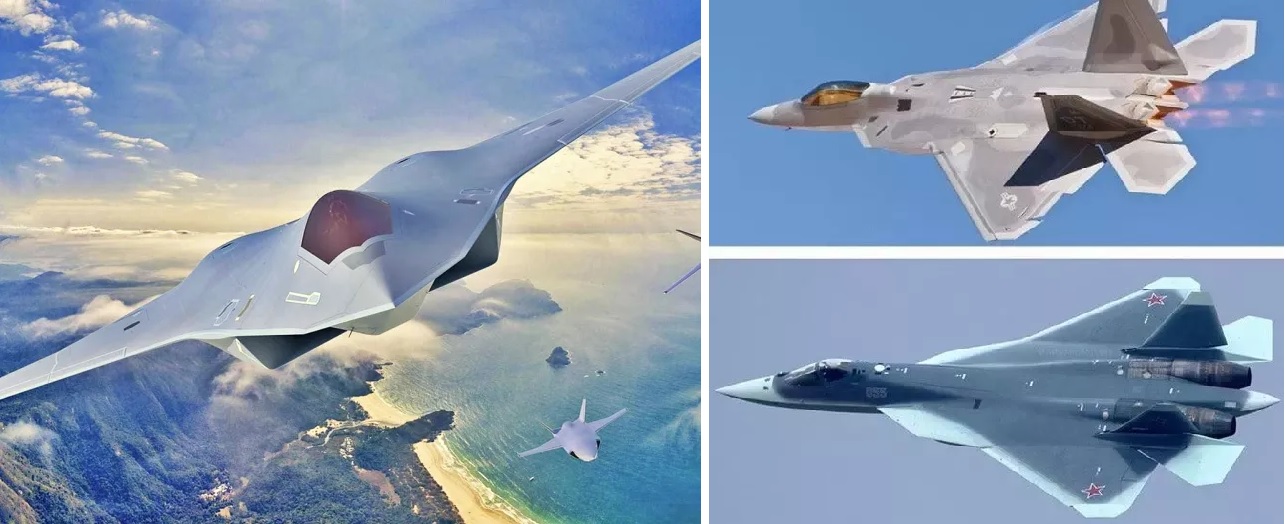 Key Differences Between 5th vs. 6th Generation Fighter Jets
Key Differences Between 5th vs. 6th Generation Fighter Jets
-
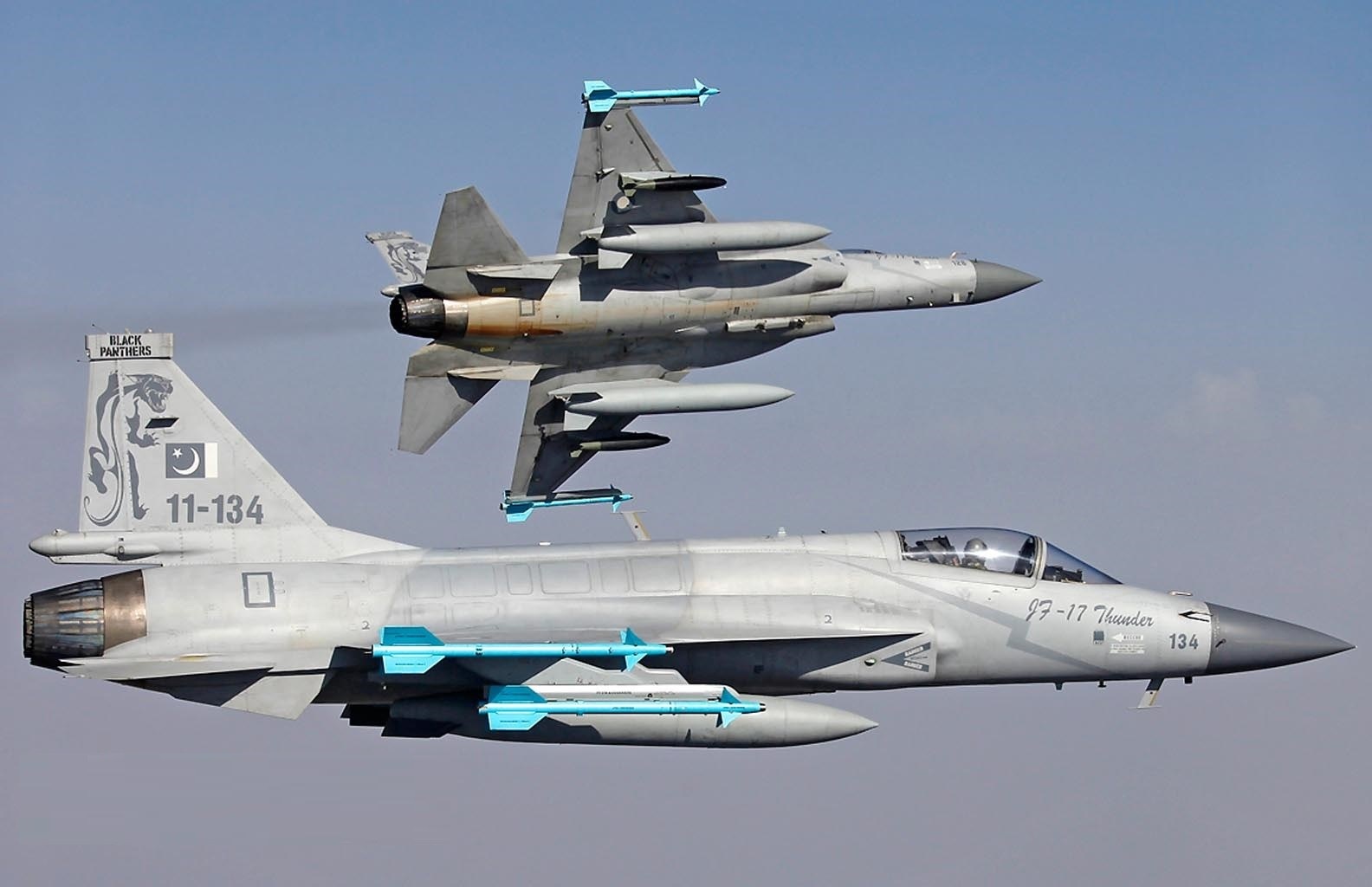 Pakistan Air Force to Unveil Stealth-Enhanced JF-17 Block 4 Fighter Jet by 2028
Pakistan Air Force to Unveil Stealth-Enhanced JF-17 Block 4 Fighter Jet by 2028
-
 India’s AMCA Engine Decision: Safran vs. Rolls-Royce Final Expected by 2025
India’s AMCA Engine Decision: Safran vs. Rolls-Royce Final Expected by 2025
-
 Pakistan Announces 15% Increase in Defence Budget for 2024-25 Amid Economic Crisis
Pakistan Announces 15% Increase in Defence Budget for 2024-25 Amid Economic Crisis
-
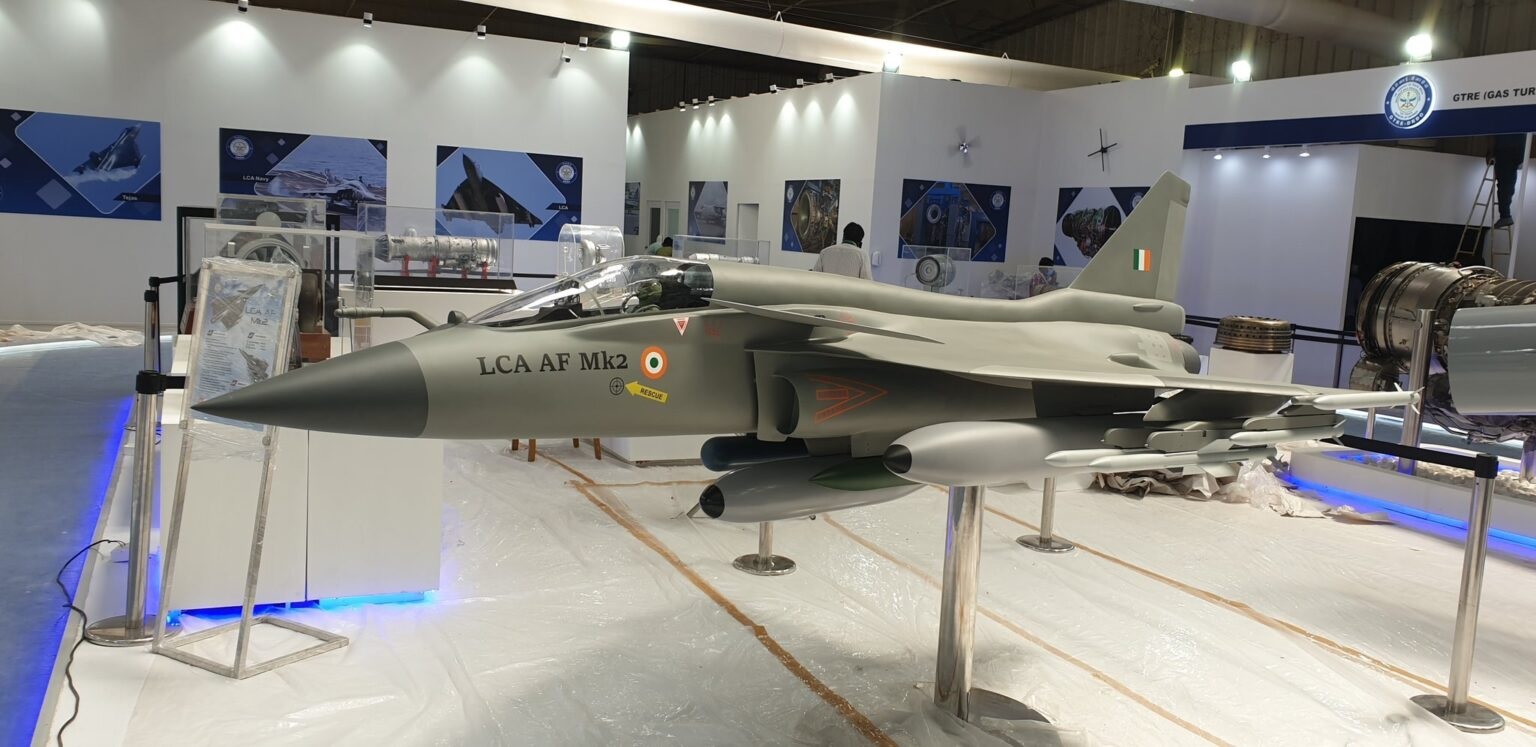 Tejas Mk2 Nears 2025 Rollout as HAL Ramps Up Final Assembly and System Integration
Tejas Mk2 Nears 2025 Rollout as HAL Ramps Up Final Assembly and System Integration
-
 India's TEDBF Program Takes Shape First Flight by 2028: Aiming for Naval Supremacy with Advanced Stealth and Technology
India's TEDBF Program Takes Shape First Flight by 2028: Aiming for Naval Supremacy with Advanced Stealth and Technology
Top Trending in 4 Days
-
 Ukrainian An-124 “Ruslan” Makes Secretive Landing in Israel, Fueling Speculation of Covert Military Support to Kyiv
Ukrainian An-124 “Ruslan” Makes Secretive Landing in Israel, Fueling Speculation of Covert Military Support to Kyiv
-
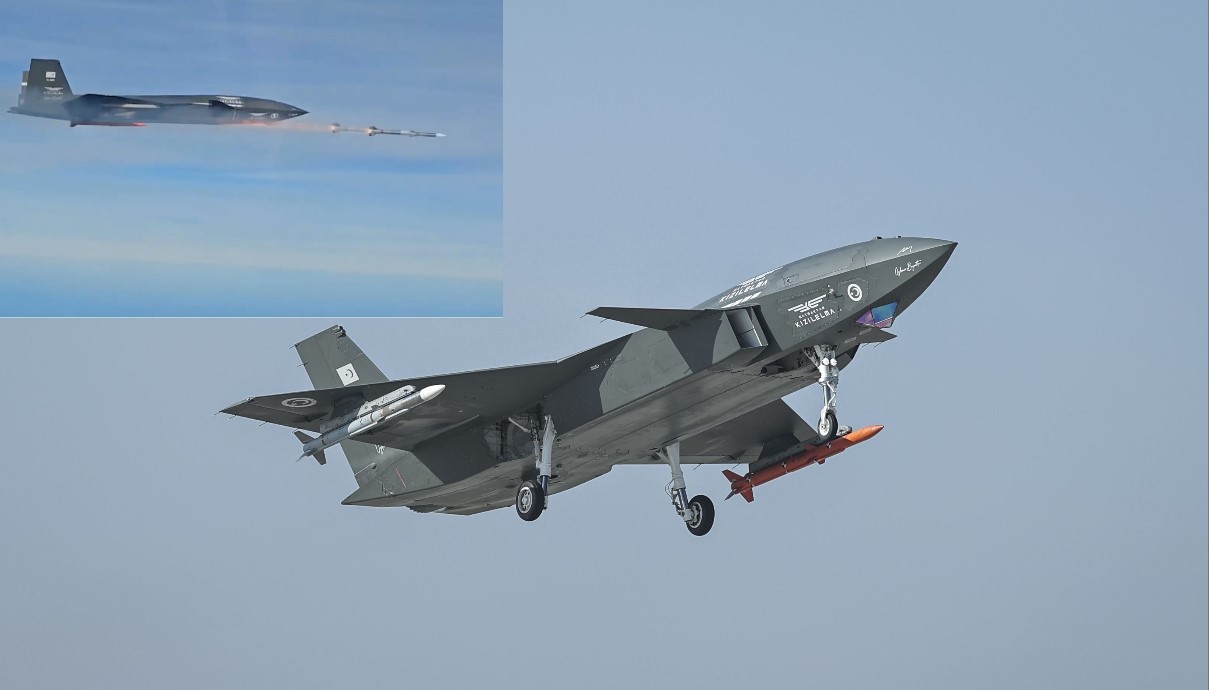 Türkiye’s Bayraktar Kizilelma Becomes First Unmanned Fighter to Shoot Down an Aerial Target with Air-to-Air Missile
Türkiye’s Bayraktar Kizilelma Becomes First Unmanned Fighter to Shoot Down an Aerial Target with Air-to-Air Missile
-
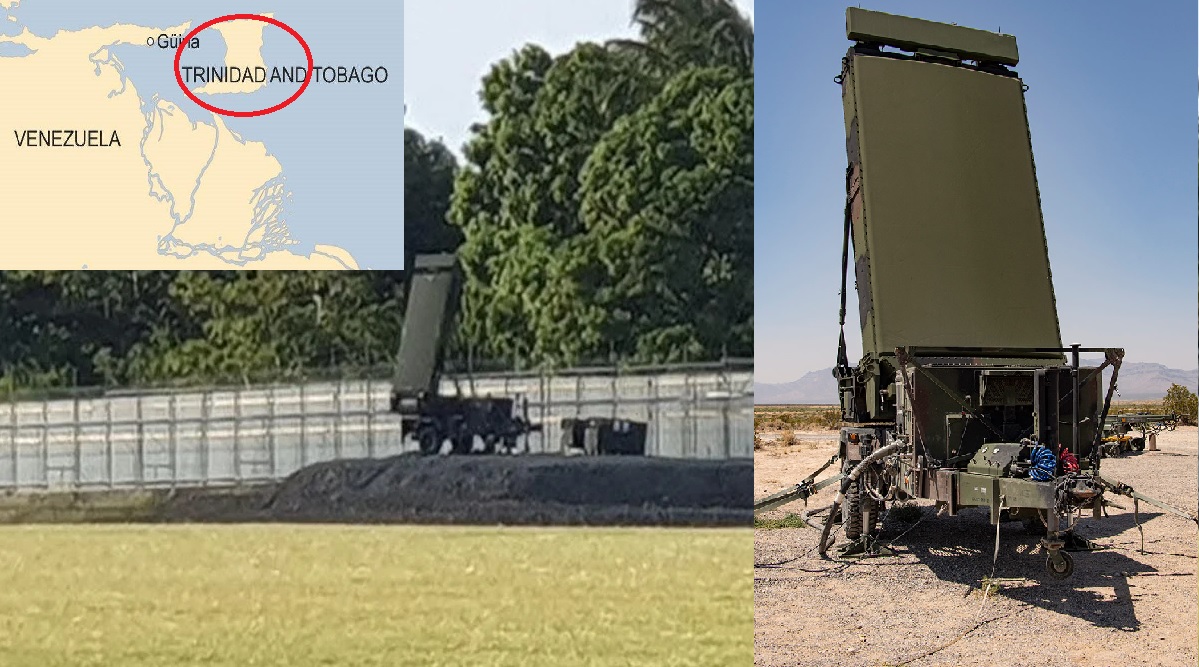 US Marines Install G/ATOR Radar in Tobago For Surveillance Over Southern Caribbean and Venezuela
US Marines Install G/ATOR Radar in Tobago For Surveillance Over Southern Caribbean and Venezuela
-
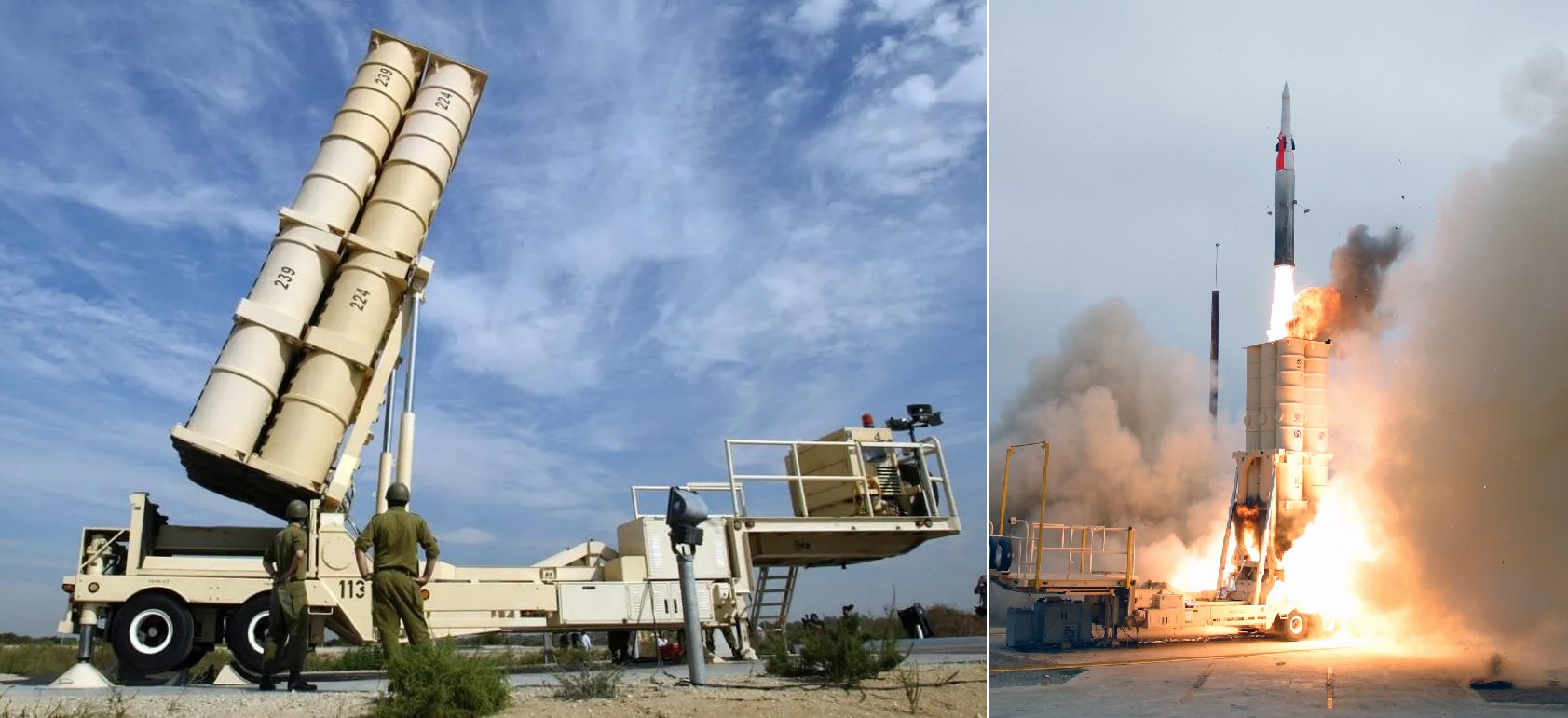 Germany Activates Israel’s Arrow-3, Europe’s First Space-Shield Against Ballistic Missiles
Germany Activates Israel’s Arrow-3, Europe’s First Space-Shield Against Ballistic Missiles
-
 Venezuela Prepares Asymmetric War Plan: Sabotage, Ambushes, and Guerrilla Attacks Against a Possible US Strike
Venezuela Prepares Asymmetric War Plan: Sabotage, Ambushes, and Guerrilla Attacks Against a Possible US Strike
-
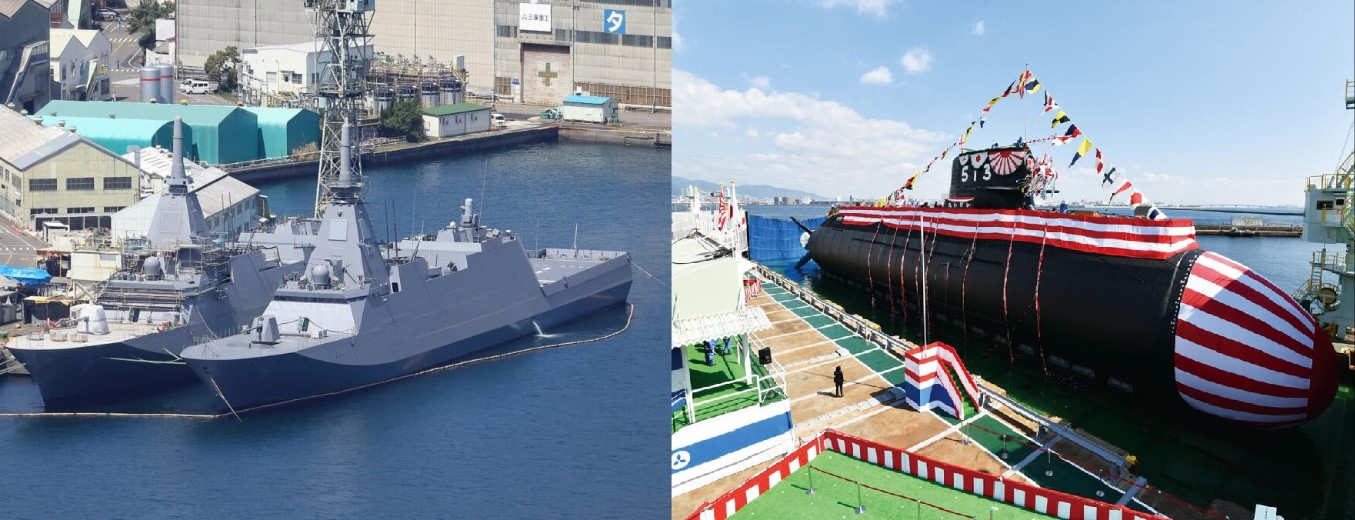 Japan Approves $5.4 billion Supplementary Defense Budget For Accelerate Frigate and Submarine Construction
Japan Approves $5.4 billion Supplementary Defense Budget For Accelerate Frigate and Submarine Construction
-
 America’s Secret F-47 “Ghost Eagle” Fighter Jet Fly With Five Armed Autonomous Drones
America’s Secret F-47 “Ghost Eagle” Fighter Jet Fly With Five Armed Autonomous Drones
-
 Zelensky Under Pressure as MP Claims He Has Been “Ordered to Resign" Within This Month
Zelensky Under Pressure as MP Claims He Has Been “Ordered to Resign" Within This Month

